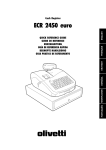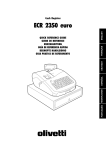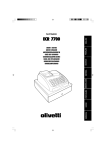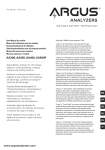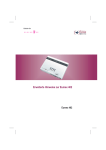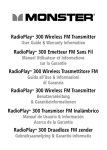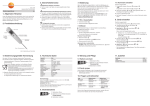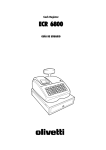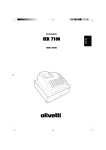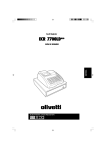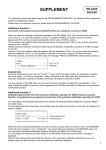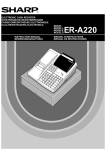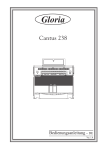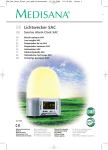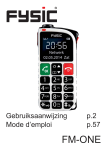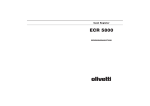Download ECR 5500
Transcript
Cash Register FRANÇAIS DEUTSCH ESPAÑOL NEDERLANDS PORTUGUÊS QUICK REFERENCE GUIDE GUIDE DE REFERENCE KURZANLEITUNG GUÍA DE REFERENCIA RÁPIDA BEKNOPTE HANDLEIDING GUIA PRATICO DE REFERIMENTO ENGLISH ECR 5500 PUBLICATION ISSUED BY: Olivetti Tecnost, S.p.A. 77, Via Jervis - 10015 Ivrea (To) Italy Copyright © 2003, Olivetti All rights reserved Quick Reference Guide QUICK START Plug the cash register into the power outlet and then insert three charged "AA" size memory backup batteries in the battery compartment as explained in the section Inserting/Replacing Batteries of the Instructions Manual. During cash register operation, all transaction data for the management report are stored in the register's memory. This memory also holds all optional programming information. The memory back-up battery system keeps this information stored in memory when the cash register is turned off or when a power failure occurs. All data stored in memory will be canceled if you unplug the cash register from the electrical wall outlet without back-up battery supply. Load the standard roll of thermal paper tape as explained in the related section of the Instructions Manual. 1. SET THE DATE 1. Open the printer compartment cover and slide the control switch to the PRG position. 2. Type the [numeric keys] representing the current date. Use the DDMMYY format. Single digit numbers for months and days must be preceded by a zero (0). 3. Press the [#/NS] key to store the date. 4. Program another feature or exit the program mode by sliding the control switch to the OFF position. Example: Set a date of September 29, 2003. Type/Press: [290903] + [#/NS] NOTE: If you wish that the date just entered be printed in the month/day/year format, type [70] and then press the [RA/FC] key. 2. SET THE TIME 1. Open the printer compartment cover and slide the control switch to the PRG position. 2. Type the [current time] using the HH:MM format. Time is set according to international, or military time (24hour clock format). To correctly enter this time, simply add 12 to all hours in the PM. For example, to set the time to 9:00 AM, type [0900]; to set the time to 2:15 PM, type [1415]. 3. Press the [Qty/Time] key to store the entered time. 4. Program another feature or exit the program mode by sliding the control switch to the OFF position. Example: Set the time at 3:30 PM. Type/Press: [1530] + [Qty/Time] NOTE: If you wish that the time just entered be printed and displayed in the 24-hour format, type [40] and then press the [RA/FC] key. 1 ENGLISH Unpack the cash register and place it on a level, stable, vibration-free and dust-free surface near a grounded power outlet. 3. SET YOUR LANGUAGE 1. Open the printer compartment cover and slide the control switch to the PRG position. 2. Type [11] followed by [1] and [RA/FC] to print in French, [11] followed by [2] and [RA/FC] to print in German, [11] followed by [3] and [RA/FC] to print in Spanish or [11] followed by [4] and [RA/FC] to print in Dutch. To print in English again, type [11] followed by [0]. 3. Program another feature or exit the program mode by sliding the control switch to the OFF position. Example: Program the cash register to print in French. Type/Press: [11] + [1] + [RA/FC] 4. PERSONALIZE THE RECEIPT HEADER 1. Open the printer compartment cover and slide the control switch to the PRG position. 2. Switch the cash register to the receipt header definition mode by pressing the [#/NS] key repeatedly until displaying the message "H01" indicating the first line of the receipt header. 3. Select the receipt header line that you wish to personalize by pressing the [Department 1/9] key repeatedly until displaying the desired line number on the left-hand side of the operator display. Remember that a total of four header lines can be personalized. You can scroll backward through the receipt header lines by pressing the [Department 5/13] key repeatedly. 4. Using the Character Code Table provided in the Appendix of the Instructions Manual. type the character code string for the letters to be entered on this particular line selected. Remember that up to 24 characters can be entered. If you wish to center a writing, you will need to calculate the empty character spaces before and after your string and type the appropriate blank space code (00) in the corresponding places. 5. Press the [Check] key again to store the newly defined header line. This new line is automatically printed. 6. Repeat steps 3, 4 and 5 if you wish to program the remaining three programmable header lines. 7. Exit from this programming sequence by pressing the [Amt Tend/TOTAL] key. 8. Program another feature or exit the program mode by sliding the control switch to the OFF position. Example: Change the third line of the default header to *PLEASE COME AGAIN* with the appropriate spaces before and after to center this new string using the Character Code Table provided in the Appendix of the Instructions Manual. Type/Press: [#/NS] + [#/NS] + [#/NS] + [#/NS] + [Department 1/9] + [Department 1/9] + [01 00 00] + [56 52 45 41 59 45 00] + [43 55 53 45 00] + [41 47 41 49 54] + [00 00 00 01] + [Check] + [Amt Tend/TOTAL] 5. PROGRAM A CURRENCY EXCHANGE RATE 1. Open the printer compartment cover and slide the control switch to the PRG position. 2. Type the identification number [1 to 4] corresponding to the foreign currency exchange rate that you wish to define. 3. Type the [decimal point position] of the exchange rate (0-8 digits after the decimal point). 4. Type the [decimal point position] of the converted amount (0-3 digits after the decimal point). 5. Type the [exchange rate] using up to six digits without specifying any decimal point. 6. Press the [Sub Total] key to store the exchange rate. 7. Program another feature or exit the program mode by sliding the control switch to the OFF position. Example: Program the first exchange rate as 1 GBP = 1.419 EURO. Type/Press: [1] + [3] + [2] + [001419] + [Sub Total] 2 6. SET A FIXED VAT RATE 1. 2. 3. 4. Open the printer compartment cover and slide the control switch to the PRG position. Type the [number] that represents the VAT (1 for VAT1, 2 for VAT2, 3 for VAT3 and 4 for VAT4). Press the [Card] key. Type the VAT rate. Up to five digits can be used, and you MUST enter three digits after the desired decimal place. For example, to enter a 5.5% VAT rate, type [5500]; to enter a 16% VAT rate, type [16000]. 5. Press the [Amt Tend/TOTAL] key. ENGLISH NOTE: If you make an error, press the [C] key and start again from step 2. 6. Program another feature or exit program mode by sliding the control switch to the OFF position. Example: Set a VAT1 rate of 5.5%, VAT2 rate of 7%, VAT3 rate of 16% and a VAT4 rate of 20%. Type/Press: [1] + [Card] + [5500] + [Amt Tend/TOTAL] [2] + [Card] + [7000] + [Amt Tend/TOTAL] [3] + [Card] + [16000] + [Amt Tend/TOTAL] [4] + [Card] + [20000] + [Amt Tend/TOTAL] 7. CHANGE THE DECIMAL POINT POSITION The decimal point setting is preset to the x.xx format. This format can be changed, as needed, to one of the other settings below. 1. Open the printer compartment cover and slide the control switch to the PRG position. 2. Type [1] followed by the status number [0, 1, 2 or 3] to select the desired format as indicated in the following table: Status Number 0 1 2 3 Format x x.x x.xx x.xxx 3. Press the [RA/FC] key to set the new format. 4. Program another feature or exit the program mode by sliding the control switch to the OFF position. Example: Program the cash register so that two digits are left after the decimal point. Type/Press: [1] + [2] + [RA/FC] 3 8. LINK A MULTIPLE/SINGLE ITEM SALE, TAX STATUS AND ITEM PRICE TO A DEPARTMENT Programming a department consists of assigning a multiple/single item sale and a tax status to it. You can then optionally assign a preset price to the department. A 3-digit department status can be programmed by using the following options: Multiple/Single Item Sales Tax Status 0 = Multiple Item Sales 1 = Single Item Sales 00 = Non taxable 01 = Taxable with VAT 1 02 = Taxable with VAT 2 03 = Taxable with VAT 3 04 = Taxable with VAT 4 1. Open the printer compartment cover and slide the control switch to the PRG position. 2. Type the [Multiple/Single Item Sales] and [Tax Status] options by referring to the previous table. A 3-digit status code must be entered. 3. Press the [Check] key to confirm your entry. 4. Type a [unit price] to assign to a specific item and then assign it to a department by pressing the related [Department] key. Use the [Dept Shift] key for departments from 9 to 16. 5. Program another feature or exit the program mode by sliding the control switch to the OFF position. Example: Program a multiple item sale, VAT 2 and a price of £2.50 to an item in Department 2. Type/Press: [0] + [0] + [2] + [Check] + [250] + [Department 2/10] 9. NAME THE DEPARTMENTS 1. Open the printer compartment cover and slide the control switch to the PRG position. 2. Switch the cash register to the department name definition mode by pressing the [#/NS] key repeatedly until displaying the message "d01" indicating the first customizable department. 3. Select the number of the department whose name you wish to define by pressing the [Department 1/9] key repeatedly until displaying the desired department number on the left-hand side of the operator display. Remember that you can name a total of 16 departments. You can scroll backward through the departments by pressing the [Department 5/13] key repeatedly. 4. With reference to the Character Code Table provided in the Appendix of the Instructions Manual. type the string of character codes to define the letters of a name to assign to the department and then press the [Check] key. Remember that the department descriptor can be up to 12 characters long. The name entered will be automatically printed. 5. Repeat steps 3 and 4 for all desired department names. Note that when you are defining department names consecutively, it is not necessary to select the department number each time. The system automatically prompts you with the next department number. When finished, exit from this programming sequence by pressing the [Amt Tend/Total] key. 6. Program another feature or exit the program mode by sliding the control switch to the OFF position. Example: Name department 3 "BOOKS" by using the Character Code Table provided in the Appendix of the Instructions Manual. Type/Press: [#/NS] + [#/NS] + [Department 1/9] + [Department 1/9] + [42 55 55 51 59] + [Check] + [Amt Tend/Total] 4 10. CREATE A FIXED PRICE LOOK-UP (PLU) Open the printer compartment cover and slide the control switch to the PRG position. Press the [Qty/Time] key. Type [the PLU number (between 1 and 200)] and then press the [PLU] key. Type the [unit price] that you wish to assign to that PLU. Press the appropriate [Department] key to assign the PLU to a Department from 1 to 16. If tax is required for a particular PLU item, be sure to link the PLU number related to the item to a department that is programmed for tax. To program a department for tax, refer to the section Link a Multiple/Single Item Sale, Tax Status and Item Price to a Department. 5. Press the [Qty/Time] key and then program another feature or exit the program mode by sliding the control switch to the OFF position. Example: Create PLU 1 with a unit price of £2.69 assigned to Department 3 and then create PLU 3 with a unit price of £5.00 assigned to Department 8. Type/Press: [Qty/Time] + [1] + [PLU] + [269] + [Department 3/11] + [3] + [PLU] + [500] + [Department 8/16] + [Qty/Time] 11. NAME PLU ITEMS 1. Open the printer compartment cover and slide the control switch to the PRG position. 2. Switch the cash register to the PLU name definition mode by pressing the [#/NS] key to display the message "P001" indicating the first PLU. 3. Select the number of the PLU whose name you wish to define by either pressing the [Department 1/9] key repeatedly until displaying the desired PLU number on the left-hand side of the operator display or by simply typing the [PLU number] and then pressing the [PLU] key. Remember that you can name all the 200 PLUs available. 4. With reference to the Character Code Table provided in the Appendix of the Instructions Manual, type the string of character codes to define the letters of a name to assign to the PLU and then press the [Check] key. Remember that the PLU descriptor can be up to 12 characters long. The name entered will be automatically printed once it is defined. 5. Repeat steps 3 and 4 for all desired PLU names. Note that when you are defining PLU names consecutively, it is not necessary to select the PLU number each time. The system automatically prompts you with the next PLU number. When finished, exit from this programming sequence by pressing the [Amt Tend/Total] key. 6. Program another feature or exit the program mode by sliding the control switch to the OFF position. Example: Name PLU 1 "COFFEE", PLU 3 "MIN. WATER" and PLU 5 "PAPERBACK" by using the Character Code Table provided in the Appendix of the Instructions Manual. Type/Press: [#/NS] + [43 55 46 46 45 45] + [Check] + [Department 1/9] + [53 49 54 05 00 63 41 60 45 58] + [Check] + [5] + [PLU] + [56 41 56 45 58 42 41 43 51] + [Check] + [Amt Tend/Total] 12. PROGRAM A SECRET CODE LINKED TO A CLERK NUMBER 1. 2. 3. 4. 5. 6. Open the printer compartment cover and slide the control switch to the PRG position. Type [44444] followed by [1] and then press the [Amt Tend/Total] key to activate the Clerk system. Type [444444] and press the [Amt Tend/Total] key. Type a number from [1 to 6] to identify the clerk to whom the secret code will be linked. Define a three-digit secret code by typing three [numeric keys]. Press the [Clerk] key. Repeat the above operations (from step 3 to step 6) to assign a secret code to the remaining 5 Clerks or use the [C] key to exit from Clerk Secret Code programming. If you wish to change the clerk's secret code and the Clerk system is already activated, there is no need to perform step 2 above. Example: Assign secret code 106 to Clerk 1 for the first time. Type/Press: [44444] + [1] + [Amt Tend/Total] + [444444] + [Amt Tend/Total] + [1] + [106] + [Clerk] 5 ENGLISH 1. 2. 3. 4. 13. DEFINE A CLERK NAME You can program a clerk name or identifier of up to 12 characters long by using the Character Code Table provided in the Appendix of the Instructions Manual. 1. Open the printer compartment cover and slide the control switch to the PRG position. 2. Switch the cash register to the Clerk name definition mode by pressing the [#/NS] key repeatedly until displaying the message "C01" indicating the first Clerk number. 3. Select the Clerk number corresponding to the Clerk whose name you wish to define by pressing the [Department 1/9] key repeatedly until displaying the number on the right hand side of the operator display. You can also use the [Department 5/13] key to scroll backwards through the Clerk numbers. 4. With reference to the Character Code Table provided in the Appendix of the Instructions Manual, type the string of character codes to define the letters of a name and then press the [Check] key. The name entered will be automatically printed. 5. Exit from this programming sequence by pressing the [Amt Tend/TOTAL] key. 6. Program another feature or exit the program mode by sliding the control switch to the OFF position. Example: Program Christina as the name for Clerk number 2. Type/Press: [#/NS] + [#/NS] + [#/NS] + [Department 1/9] + [43 74 84 75 85 86 75 80 67] + [Check] + [Amt Tend/TOTAL] 6 Guide de Reference DÉMARRAGE RAPIDE FRANÇAIS Brancher la caisse enregistreuse à la prise de courant et ensuite introduire les trois piles pour la mémoire tampon “AA” dans le compartiment batterie comme expliqué dans la section Introduire/Remplacer les piles du manuel d’instructions. Lorsque la caisse est en service, toutes les données d’enregistrement nécessaires aux compterendus de gestion sont mémorisées dans la mémoire de la caisse enregistreuse. Cette mémoire contient aussi toutes les informations concernant les programmes fonctionnels. Le système de sauvegarde des données en mémoire conserve ces informations grâce à des piles lorsque la caisse n’est plus alimentée ou en cas de panne de courant. Si l’on déconnecte la caisse sans avoir monté les piles, toutes les données en mémoire seront perdues. ENGLISH Placer la caisse sur une surface plane, stable, sans vibrations et sans poussière. S’assurer qu’elle se trouve à proximité d’une prise de courant possédant un conducteur de terre. Charger le rouleau de papier standard comme expliqué dans la section relative du manuel d’instructions. 1. RÉGLER LA DATE 1. Ouvrir le compartiment de l'imprimante et faire glisser le commutateur de commande sur la position PRG. 2. Appuyer sur les [touches numériques] représentant la date courante. Bien respecter le format JJMMAA. Les nombres à un seul chiffre des jours et des mois doivent être précédés d’un zéro (0). 3. Appuyer sur la touche [#/NS] pour mettre la date en mémoire. 4. Programmer une autre fonction ou quitter le mode programme en faisant glisser le commutateur de commande sur la position OFF. Exemple: Programmer la date 29 septembre, 2003. Taper/Appuyer: [290903] + [#/NS] REMARQUE: Si vous voulez que la date à peine saisie soit imprimée dans le format mois/jour/an, taper [70] et ensuite appuyer sur [RA/FC]. 2. RÉGLER L’HEURE 1. Ouvrir le compartiment de l'imprimante et faire glisser le commutateur de commande sur la position PRG. 2. Taper l’[heure courante] sous la forme HH:MM. L’heure est programmée sous la forme internationale (forme à 24 heures). Il faut donc ajouter 12 pour programmer les heures de l’après-midi. Par exemple, pour programmer 9 heures du matin, introduire [0900]; pour programmer 2h15 de l’après-midi, introduire [1415]. 3. Appuyer sur la touche [Qty/Time] pour mettre l’heure en mémoire. 4. Programmer une autre fonction ou quitter le mode programme en faisant glisser le commutateur de commande sur la position OFF. Exemple: Programmer 3h30 de l’après-midi. Taper/Appuyer: [1530] + [Qty/Time] REMARQUE: Si vous voulez que l’heure à peine programmée soit imprimée et affichée dans le format 24 heures, taper [40] et ensuite appuyer sur [RA/FC]. 1 3. PROGRAMMEZ VOTRE LANGUE 1. Ouvrir le compartiment de l'imprimante et faire glisser le commutateur de commande sur la position PRG. 2. Taper [11] suivi de [1] et [RA/FC] pour imprimer en Français, [11] suivi de [2] et [RA/FC] pour imprimer en Allemand, [11] suivi de [3] et [RA/FC] pour imprimer en Espagnol ou [11] suivi de [4] et [RA/FC] pour imprimer en Hollandais. Pour imprimer en Anglais à nouveau, taper [11] suivi de [0]. 3. Programmer une autre fonction ou quitter le mode programme en faisant glisser le commutateur de commande sur la position OFF. Exemple: Programmer la caisse enregistreuse pour imprimer en Français. Taper/Appuyer: [11] + [1] + [RA/FC] 4. PERSONNALISER L’EN TETE DU TICKET DE CAISSE 1. Ouvrir le compartiment de l'imprimante et faire glisser le commutateur de commande sur la position PRG. 2. Placer la caisse enregistreuse sur le mode de définition de l’en-tête ticket en appuyant sur la touche [#/NS] plusieurs fois jusqu’à ce qu’apparaisse un message "H01" indiquant la première ligne de l’en-tête. 3. Selectionner la ligne que l’on veut personnaliser en appuyant sur [Rayon 1/9] plusieurs fois de suite jusqu’à l’affichage du numéro de ligne requis du côté gauche de l’afficheur opérateur. Se rappeler qu’un total maximum de quatre lignes peut être personnalisé. Vous pouvez quitter en appuyant sur [Rayon 5/13] plusieurs fois de suite. 4. En utilisant le Tableau Codes Caractères fourni dans l’annexe du manuel Instructions d'emploi taper la rangée de codes caractères pour les lettres qui doivent être saisies dans la ligne particulière sélectionné. Se rappeler que l’on peut saisir jusqu’à 24 caractères. Si vous voulez placer au centre une ligne, vous devez calculer les espaces vides avant et après la rangée et taper l’espace blanc approprié (00) dans les espaces appropriés. 5. Appuyer sur [Check] nouveau pour emmagasiner la ligne du nouvel en-tête. Cette nouvelle ligne est automatiquement imprimée. 6. Répéter les points 3, 4 et 5 si vous désirez programmer les trois autres lignes de l’en-tête. 7. Quitter le programme en appuyant sur [Amt Tend/TOTAL]. 8. Programmer une autre fonction ou quitter le mode programme en faisant glisser le commutateur de commande sur la position OFF. Exemple: Changer la troisième ligne de défaut de l’en-tête avec *AU REVOIR!* avec le Tableau Codes Caractères fourni dans l’annexe du manuel Instructions d'emploi et les espaces avant et après la ligne. Taper/Appuyer: [#/NS] + [#/NS] + [#/NS] + [#/NS] + [Rayon 1/9] + [Rayon 1/9] + [01 00 00 00 00 00 00] + [41 61 00] + [58 45 62 55 49 58 21] + [00 00 00 00 00 00 01] + [Check] + [Amt Tend/TOTAL] 5. CHANGER LA POSITION DE LA VIRGULE DÉCIMALE 1. Ouvrir le compartiment de l'imprimante et faire glisser le commutateur de commande sur la position PRG. 2. Taper le numéro d’identification [1 à 4] correspondant au taux de change de la devise étrangère que vous voulez définir. 3. Taper la [position de la virgule décimale] du taux de change (0-8 chiffres après la virgule décimale). 4. Taper la [position de la virgule décimale] de la somme convertie (0-3 chiffres après la virgule décimale). 5. Taper le [taux de change] en utilisant six chiffres sans aucune virgule décimale. 6. Appuyer sur [Sub Total] pour mémoriser le taux de change. 7. Programmer une autre fonction ou quitter le mode programme en faisant glisser le commutateur de commande sur la position OFF. Exemple: Programmer le premier taux de change tel que 1 EUR = 1,1579 USD. Taper/Appuyer: [1] + [4] + [2] + [011579] + [Sub Total] 2 6. DEFINIR UN TAUX DE TVA FIXE Ouvrir le compartiment de l'imprimante et faire glisser le commutateur de commande sur la position PRG. Taper le [numéro] qui représente la TVA (1 pour TVA1, 2 pour TVA2, 3 pour TVA3 et 4 pour TVA4). Appuyer sur [Card]. Taper le taux de TVA. On peut utiliser jusqu’à cinq chiffres et IL FAUT programmer trois chiffres après la position de la virgule décimale. Par exemple, pour programmer un taux de TVA 5.5%, taper [5500]; pour programmer un taux de TVA de 16%, taper [16000]. 5. Appuyer sur [Amt Tend/TOTAL]. REMARQUE: En cas d’erreur, appuyer sur [C] et recommencer en partant du point 2. 6. Programmer une autre fonction ou quitter le mode programme en faisant glisser le commutateur de commande sur la position OFF. Exemple: Programmer un taux de TVA1 de 5.5%, un taux de TVA2 de 7%, un taux de TVA3 de 16% et un taux de TVA4 de 20%. 7. FRANÇAIS Taper/Appuyer: [1] + [Card] + [5500] + [Amt Tend/TOTAL] [2] + [Card] + [7000] + [Amt Tend/TOTAL] [3] + [Card] + [16000] + [Amt Tend/TOTAL] [4] + [Card] + [20000] + [Amt Tend/TOTAL] CHANGER LA POSITION DE LA VIRGULE DÉCIMALE La position de la virgule décimale est définie par le format x,xx. Ce format peut être changé selon les besoins en utilisant les indications suivantes. 1. Ouvrir le compartiment de l'imprimante et faire glisser le commutateur de commande sur la position PRG. 2. Tapez [1] suivi du numéro de l’état [0, 1, 2 ou 3] pour choisir le format désiré selon les indications de la table suivante: Code 0 1 2 3 ENGLISH 1. 2. 3. 4. Format x x.x x.xx x.xxx 3. Appuyer sur la touche [RA/FC] pour enregistrer le nouveau format. 4. Programmer une autre fonction ou quitter le mode programme en faisant glisser le commutateur de commande sur la position OFF. Exemple: Programmer la caisse de façon à obtenir deux chiffres après la virgule. Taper/Appuyer: [1] + [2] + [RA/FC] 3 8. RELIER UNE VENTE MULTIPLE/A L’UNITE, UN REGIME DE TAXATION ET UN PRIX AU RAYON D’ARTICLES Programmer le rayon consiste à lui assigner une vente multiple/à l’unité et un régime de taxation. Vous pourrez ensuite attribuer un prix pré-enregistré à le rayon. Un état du rayon à 3 chiffres peut être programmé à l’aide des options suivantes: Vente multiple/à l’unité Régime de taxation 0 = Multiple 1 = A l’unité 00 = Non taxable 01 = Taxable avec 02 = Taxable avec 03 = Taxable avec 04 = Taxable avec TVA TVA TVA TVA 1 2 3 4 1. Ouvrir le compartiment de l'imprimante et faire glisser le commutateur de commande sur la position PRG. 2. Entrer les options de [Vente multiple/à l’unité] et [Régime Taxation] en se reportant à la table précédente. Vous devez entrer un code du rayon à 3 chiffre. 3. Appuyer sur la touche [Check] pour confirmer les options introduites. 4. Taper le [prix unitaire] à attribuer à un article spécifique et l’associer ensuite à un rayon en appuyant sur la touche [Rayon]. Utiliser la touche [Dept Shift] pour les rayons de 9 à 16. 5. Programmer une autre fonction ou quitter le mode programme en faisant glisser le commutateur de commande sur la position OFF. Exemple: Assignez une vente multiple, une TVA 2 et un prix de 2,50 EUR à un article en Rayon 2. Taper/Appuyer: [0] + [0] + [2] + [Check] + [250] + [Rayon 2] 9. NOMMER LES RAYONS 1. Ouvrir le compartiment de l'imprimante et faire glisser le commutateur de commande sur la position PRG. 2. Programmer le mode de définition du nom du rayon de la caisse en appuyant sur la touche [#/NS] plusieurs fois de suite jusqu’à ce qu’apparaisse le message "d01" indiquant que vous pouvez définir le premier rayon. 3. Sélectionner le numéro du rayon auquel vous voulez attribuer le nom en appuyant sur la touche [Rayon 1/9] plusieurs fois de suite jusqu’à ce qu’apparaisse le numéro du rayon requis du côté gauche de l’afficheur opérateur. Se souvenir que l’on peut mémoriser jusqu’à 16 rayons. Vous pouvez voir tous les Rayon en appuyant plusieurs fois de suite sur la touche [Rayon 5/13]. 4. En se référant au Tableau Code Caractèrs fourni dans l’annexe du manuel Instructions d'emploi taper la rangée des codes caractères pour définir les lettres du nom à donner au rayon et ensuite appuyer sur [Check]. Se souvenir que la description du rayon peut contenir jusqu’à 12 caractères. Le nom attribué sera automatiquement imprimé. 5. Répéter les pointse 3 et 4 pour tous les noms rayons désirés. A remarquer que lorsque vous êtes en train de définir les noms des rayons de manière consécutive, il n’est pas nécessaire de sélectionner le numéro rayon à chaque fois. Le système vous donnera en automatique le numéro rayon successif. Lorsque vous avez terminé, quittez en appuyant sur [Amt Tend/Total]. 6. Programmer une autre fonction ou quitter le mode programme en faisant glisser le commutateur de commande sur la position OFF. Exemple: Nommer un Rayon 3 "LIVRES" en utilisant le Tableau de Codes Caractères fourni dans l’annexe du manuel Instructions d'emploi. Taper/Appuyer: [#/NS] + [#/NS] + [Rayon 1/9] + [Rayon 1/9] + [52 49 62 58 45 59] + [Check] + [Amt Tend/Total] 4 10. CRÉER UN PRIX ENREGISTRE (PLU) Ouvrir le compartiment de l'imprimante et faire glisser le commutateur de commande sur la position PRG. Appuyer sur la touche [Qty/Time]. Taper [le numéro PLU (entre 1 et 200)] puis appuyer sur la touche [PLU]. Introduire le [prix unitaire] que l’on désire programmer pour cet article PLU. Appuyer sur la touche [Rayon] appropriée pour choisir le rayon de l’article PLU de 1 à 16. Si la taxe est nécessaire pour un article PLU particulier, assurez-vous de relier le numéro de PLU relatif à l’article à le rayon programmé pour la taxe. Pour programmer un rayon pour une taxe, reportez-vous à la section Relier une Vente multiple/à l’unité, Régime de Taxation et Prix à un rayon d'articles. 5. Appuyer sur [Qty/Time] et ensuite programmer une autre fonction ou quitter le mode programmation en faisant glisser le commutateur de commande sur la position OFF. Exemple: Créer le PLU 1 au prix unitaire de 2,69 EUR attribué à le Rayon 3 puis créer le PLU 3 au prix unitaire de 5,00 EUR attribué à le Rayon 8. ENGLISH 1. 2. 3. 4. 11. NOMMER LES ARTICLES PLU 1. Ouvrir le compartiment de l'imprimante et faire glisser le commutateur de commande sur la position PRG. 2. Pour accéder au mode programmation des noms PLU appuyer sur [#/NS] pour voir affiché le message "P001" indiquant le premier PLU. 3. Selectionner le numéro du PLU que vous voulez définir en appuyant sur [Rayon 1/9] plusieurs fois jusqu’à ce qu’apparaisse le numéro PLU requis sur le côté gauche de l’afficheur opérateur ou simplement en tapant le [numéro PLU] et ensuite en appuyant sur [PLU]. Se souvenir que vous pouvez nommer tous les 200 articles PLU disponibles. 4. En se référant au Tableau Codes Caractères fourni dans l’annexe du manuel Instructions d'emploi taper la rangée de codes des caractéres pour définir les lettres du nom à attribuer au PLU et ensuite appuyer sur [Check]. Se souvenir que la description du PLU peut avoir maximum 12 caractères. Le nom attribué sera automatiquement imprimé. 5. Répéter les points 3 et 4 pour tous les noms PLU désirés. Remarquer que lorsque l’on définit un nom PLU de manière consécutive, il n’est pas nécessaire de sélectionner le numéro PLU à chaque fois. Le système automatiquement propose le numéro successif. Après avoir terminé, quitter la programmation en appuyant sur [Amt Tend/Total]. 6. Programmer une autre fonction ou quitter le mode programme en faisant glisser le commutateur de commande sur la position OFF. Exemple: Nommer un PLU 1 "CAFE", PLU 3 "EAU MIN." et un PLU 5 "DE POCHE" en utilisant le Tableau Codes Caractères fourni dans l’annexe du manuel Instructions d'emploi. Taper/Appuyer: [#/NS] + [43 41 46 45] + [Check] + [Rayon 1/9] + [45 41 61 00 53 49 54 05] + [Check] + [5] + [PLU] + [44 45 00 56 55 43 48 45 ] + [Check] + [Amt Tend/Total] 12. DEFINIR UN CODE SECRET LIÉ À UN NUMÉRO DE VENDEUR 1. 2. 3. 4. 5. 6. Ouvrir le compartiment de l'imprimante et faire glisser le commutateur de commande sur la position PRG. Entrer [44444] suivi de [1] et appuyer sur la touche [Amt Tend/Total] pour activer le système Vendeurs. Entrer [444444] puis appuyer sur la touche [Amt Tend/TOTAL]. Entere un chiffre de [1 à 6] pour identifier le vendeur à qui sera attribué le code secret. Programmer un code secret à trois chiffres à l’aide de trois [touches numériques]. Appuyer sur la touche [Clerk]. Répéter les opérations décrites ci-dessus (du point 3 au point 6) pour attribuer un code secret aux autres 5 vendeurs ou appuyer sur la touche [C] pour quitter la programmation des Codes secrets des vendeurs. Si l’on désire modifier le code secret d’un vendeur et le Système Vendeurs a déjà été activé il n’est pas nécessaire d’exécuter le point 2 ci-dessus. Exemple : Attribution du code secret 106 au vendeur 1 pour la première fois. Taper/Appuyer: [44444] + [1] + [Amt Tend/TOTAL] + [444444] + [Amt Tend/TOTAL] + [1] + [106] + [Clerk] 5 FRANÇAIS Taper/Appuyer: [Qty/Time] + [1] + [PLU] + [269] + [Rayon 3/11] + [3] + [PLU] + [500] + [Rayon 8/16] + [Qty/Time] 13. DEFINIR UN NOM VENDEUR On peut programmer un nom vendeur ou identificateur comprenant jusqu’à 12 caractères en utilisant le Tableau des codes caractères fourni dans l’annexe du manuel Instructions d'emploi. 1. Ouvrir le compartiment de l'imprimante et faire glisser le commutateur de commande sur la position PRG. 2. Appuyer pour définir le nom vendeur sur la touche [#/NS] plusieurs fois jusqu’à ce que le message "C01" soit affiché indiquant le premier numéro vendeur. 3. Sélectionner le numéro vendeur correspondant au vendeur auquel l’on veut attribuer le nom en appuyant sur [Rayon 1/9] plusieurs fois jusqu’a ce que n’apparaisse le numéro sur le côté droit de l’afficheur opérateur. Vous pouvez aussi utiliser et appuyer sur [Rayon 5/13] pour avoir un aperçu général des numéros vendeurs. 4. En se référant au Tableau fourni dans l’annexe du manuel Instructions d'emploi taper une rangée de codes caractères pour définir les lettres du nom et ensuite appuyer sur [Check]. Le nom saisi sera automatiquement imprimé. 5. Quitter la séquence de programmation en appuyant sur [Amt Tend/TOTAL]. 6. Programmer une autre fonction ou quitter le mode programme en faisant glisser le commutateur de commande sur la position OFF. Exemple: Programmer Cristina comme nom vendeur 2. Taper/Appuyer: [#/NS] + [#/NS] + [#/NS] + [Rayon 1/9] + [43 84 75 85 86 75 80 67] + [Check] + [Amt Tend/TOTAL] 6 Kurzanleitung QUICK START Stellen Sie die Kasse auf eine ebenen, stabile, vibrations- und staubfreie Fläche. Sorgen Sie dafür, daß sich in der Nähe eine geerdete Steckdose befindet. Die Registrierkasse an die Steckdose anschließen und dann drei aufgeladene AA Datensicherungs-Batterien in das Batteriefach einsetzen wie im Anleitungshandbuch im Abschnitt über Einsetzen und Wechseln von Batterien erklärt. Während des Kassenbetriebs werden alle Vorgangsdaten für die Aufsichtsberichte im Speicher der Kasse abgelegt. Dieser Speicher enthält auch die optionale Programmierung, damit diese Speicherung bei Ausschalten der Kasse oder Stromausfall nicht verloren geht. Alle im Speicher geladenen Daten werden gelöscht, wenn Sie den Netzstecker ziehen, ohne daß entsprechende Batterien vorhanden sind. Eine Standardrolle Thermopapier einlegen wie im entsprechenden Abschnitt des Anleitungshandbuch gezeigt. 1. Den Deckel der Druckerstation öffnen und den Steuerschalter auf PRG schieben. 2. Über die [numerischen Tasten] das derzeitige Datum eingeben. Sie müssen das Format TT/MM/JJ, wobei für einstellige Monats- und Tagesdaten eine Null (0) vorangestellt werden muss. 3. Zum Speichern der Eingabe die [#/NS] Taste drücken. 4. Programmieren Sie eine weitere Funktion oder verlassen Sie den Programmiermodus, indem Sie den Kontrollschalter auf die Position OFF schieben. Beispiel: Einstellen des Datums als 29 September 2003. Eingabe/Drücken: [290903] + [#/NS] HINWEIS: Wenn Sie das gerade eingegebene Datum im Format Monat/Tag/Jahr ausdrucken wollen, [70] eingeben und die [RA/FC] Taste drücken. 2. EINSTELLEN DER UHRZEIT 1. Den Deckel der Druckerstation öffnen und den Steuerschalter auf PRG schieben. 2. Die [aktuelle Uhrzeit] im Format Stunden:Minuten eingeben. Die Uhrzeit wird im 24-Std.-Format angezeigt. Zur korrekten Eingabe der Uhrzeit muß man für die PM-Stunden (nach Mittag) einfach 12 Stunden hinzuzählen. Beispiel: Zur Eingabe der Zeit: 9.00 Uhr muß man [0900] eingeben; zur Eingabe der Zeit: 2.15 Uhr bitte [1415] eingeben. 3. Zum Speichern der Eingabe die [Qty/Time] Taste drücken. 4. Programmieren Sie eine weitere Funktion oder verlassen Sie den Programmiermodus, indem Sie den Kontrollschalter auf die Position OFF schieben. Beispiel: Die Zeit auf 3:30 setzen. Eingabe/Tastendrücken: [1530] + [Qty/Time] HINWEIS: Soll die gerade eingebene Zeit im 24 Stundenformat angezeigt und gedruckt werden, [40] geben und die [RA/FC]. 1 DEUTSCH 1. EINSTELLEN DES DATUMS 3. DIE GEWÜNSCHTE SPRACHE EINSTELLEN 1. Den Deckel der Druckerstation öffnen und den Steuerschalter auf PRG schieben. 2. Für Französisch [11] und dann [1] eingeben und [RA/FC] drücken; für Deutsch [11] und dann [2] eingeben und [RA/FC] drücken; für Spanisch [11] und dann [3] eingeben und [RA/FC] drücken; für Holländisch [11] und dann [4] eingeben und [RA/FC] drücken. Mit Eingabe von [11] gefolgt von [0] hat man wieder Englisch. 3. Programmieren Sie eine weitere Funktion oder verlassen Sie den Programmiermodus, indem Sie den Kontrollschalter auf die Position OFF schieben. Beispiel: Die Registrierkasse für Drucken in Deutsch programmieren. Eingabe/Tastendrücken: [11] + [2] + [RA/FC] 4. DEN KASSENBON-KOPF NACH IHREN WÜNSCHEN GESTALTEN 1. Den Deckel der Druckerstation öffnen und den Steuerschalter auf PRG schieben. 2. Die Registrierkasse durch wiederholtes Drücken der [#/NS] Taste bis zum Erscheinen Meldung "H01", die den erste Zeile des Kopfes anzeigt, in den Modus zum Definieren der Kopfzeilen schalten. 3. Die Zeile des Kopfes wählen, die geändert werden soll. Dazu die [Warengr. 1/9] Taste wiederholt drücken, bis die gewünschte Zeilennummer links auf dem Kassiererdisplay erscheint. Es können bis zu vier Zeilen des Kopfs geändert werden. Durch wiederholtes Drücken der [Warengr. 5/13] Taste können Sie die Zeilen rückwärts durchlaufen. 4. Mit Hilfe der Zeichencodetabelle im Anhang zum Anleitungshandbuch die Zeichenkette für die gewählte Zeile eingeben. Es können bis zu 24 Zeichen pro Zeile eingegeben werden. Soll der Schriftzug zentriert werden, müssen die Anzahl von Leerzeichen vor und hinter dem Text berechnen und dort die entsprechenden Leercodes (00) einsetzen. 5. Wieder die [Check] Taste drücken, um die neue Kopfzeile zu speichern. Diese neue Zeile wird automatisch ausgedruckt. 6. Die Schritte 3, 4 und 5 wiederholen, wenn auch die anderen drei Kopfzeilen programmiert werden sollen. 7. Diese Programmiersequenz durch Drücken der [Amt Tend/TOTAL] Taste verlassen. 8. Programmieren Sie eine weitere Funktion oder verlassen Sie den Programmiermodus, indem Sie den Kontrollschalter auf die Position OFF schieben. Beispiel: Ändern der dritten Zeile des Standardkopfes in *KOMMEN SIE WIEDER* mit Leerzeichen vor und hinter dem Text, so dass er in der Mitte steht. Benutzen der Zeichencodetabelle im Anhang zum Anleitungshandbuch. Eingabe/Drücken: [#/NS] + [#/NS] + [#/NS] + [#/NS] + [Warengr. 1/9] + [Warengr. 1/9] + [01 00 00] + [51 55 53 53 45 54 00] + [59 49 45 00] + [63 49 45 44 45 58] + [00 00 00 01] + [Check] + [Amt Tend/TOTAL] 5. PROGRAMMIEREN EINES WECHSELKURSES 1. 2. 3. 4. 5. 6. 7. Den Deckel der Druckerstation öffnen und den Steuerschalter auf PRG schieben. Geben Sie die Kennziffer [1 bis 4] für den Wechselkurs ein, der definiert werden soll. Geben Sie die [Nachkommastellen] für den Wechselkurs ein (0-8 Stellen). Geben Sie die [Nachkommastellen] für den umgerechneten Betrag ein (0 - 3 Stellen). Geben Sie den [Wechselkurs] mit 6 Ziffern ohne Dezimalpunkt ein. Zum Speichern des Wechselkurses die [Sub Total] Taste drücken. Programmieren Sie eine weitere Funktion oder verlassen Sie den Programmiermodus, indem Sie den Kontrollschalter auf die Position OFF schieben. Beispiel: Programmieren des ersten Wechselkurses - 1 EURO = 1,1579 US$. Eingabe/Drücken: [1] + [4] + [2] + [011579] + [Sub Total] 2 6. EINSTELLEN EINER FESTEN MWST-RATE 1. Den Deckel der Druckerstation öffnen und den Steuerschalter auf PRG schieben. 2. Die [Nummer] für den MWSt. Satz eingeben, der programmiert werden soll (1 für MWSt.1, 2 für MWSt.2 u.s.w.). 3. Die [Card] Taste drücken. 4. Den Mehrwertsteuersatz eingeben. Es können bis zu fünf Stellen benutzt werden. Sie MÜSSEN aber mindestens drei Nachkommastellen angeben. Für einen Mehrwertsteuersatz von 5,5% geben Sie z.B. [5500] ein, für 16% geben Sie [16000] ein. 5. Die [Amt Tend/TOTAL] Taste drücken. HINWEIS: Wenn Sie einen Fehler gemacht haben, drücken Sie die [C] Taste und beginnen wieder mit Schritt 2. 6. Programmieren Sie eine weitere Funktion oder verlassen Sie den Programmiermodus, indem Sie den Kontrollschalter auf die Position OFF schieben. Beispiel: MWSt.1 mit 5,5%, MWSt. 2 mit 7%, MWSt.3 mit 16% und MWSt.4 mit 20% programmieren. 7. ÄNDERN DER DEZIMALPUNKTPOSITION Standardmäßig ist das Format x,xx, also mit zwei Nachkommastellen, programmiert. Diese Einstellung kann nach Bedarf auf eines der anderen unten angegebenen Formate geändert werden. 1. Den Deckel der Druckerstation öffnen und den Steuerschalter auf PRG schieben. 2. Geben Sie [1] gefolgt von der Statusnummer [0, 1, 2 oder 3] ein, um das gewünschte Format wie in der folgenden Tabelle gezeigt zu wählen: Statusnummer 0 1 2 3 Format x x,x x,xx x,xxx 3. Zum Setzen des neuen Formates die [RA/FC] Taste drücken. 4. Programmieren Sie eine weitere Funktion oder verlassen Sie den Programmiermodus, indem Sie den Kontrollschalter auf die Position OFF schieben. Beispiel: Die Registrierkasse so programmieren, daß zwei Dezimalstellen angegeben werden. Eingabe/Tastendrücken: [1] + [2] + [RA/FC] 3 DEUTSCH Eingabe/Drücken: [1] + [Card] + [5500] + [Amt Tend/TOTAL] [2] + [Card] + [7000] + [Amt Tend/TOTAL] [3] + [Card] + [16000] + [Amt Tend/TOTAL] [4] + [Card] + [20000] + [Amt Tend/TOTAL] 8. VERKNÜPFEN VON MEHR-/EINZELPOSTENVERKAUF, STEUERSTATUS UND STÜCKPREIS MIT EINER WARENGRUPPE Das Programmieren einer Warengruppe besteht darin, ihr einen Mehr-/Einzelpostenverkauf und einen Steuerstatus zuzuweisen. Sie können ihr dann optional einen vordefinierten Preis zuweisen. Mit den folgenden Optionen kann dann ein 3-stelliger Warengruppenstatus programmiert werden: Mehr/Einzelpostenverkauf Steuerstatus 0 = Mehrpostenverkauf 1 = Einzelpostenverkauf 00 01 02 03 04 = = = = = steuerfrei besteuert besteuert besteuert besteuert mit mit mit mit MWSt.1 MWSt.2 MWSt.3 MWSt.4 1. Den Deckel der Druckerstation öffnen und den Steuerschalter auf PRG schieben. 2. Geben Sie die Optionen [Mehr/Einzelpostenverkauf] und [Steuerstatus] entsprechend der obigen Tabelle ein. Es muss ein 3-stelliger Statuscode eingegeben werden. 3. Zur Eingabebestätigung die [Check] Taste drücken. 4. Für einen bestimmten Artikel einen [Festpreis] eingeben und ihn dann durch Drücken der entsprechenden [Warengr.] Taste einer Warengruppe zuordnen. Für die Warengruppen 9 - 16 die [Dept Shift] Taste benutzen. 5. Programmieren Sie eine weitere Funktion oder verlassen Sie den Programmiermodus, indem Sie den Kontrollschalter auf die Position OFF schieben. Beispiel: Programmieren Sie einen Mehrpostenverkauf, MWSt. 2 und einen Preis von EUR 2,50 in Warengruppe 2. Eingabe/Tastendrücken: [0] + [0] + [2] + [Check] + [250] + [WARENGR. 2] 9. WARENGRUPPEN NAMEN GEBEN 1. Den Deckel der Druckerstation öffnen und den Steuerschalter auf PRG schieben. 2. Durch wiederholtes Drücken der [#/NS] Taste, bis die Meldung "d01" den ersten einrichtbaren Warengruppennamen anzeigt, in den Modus für Namensdefinition schalten. 3. Durch wiederholtes Drücken der [Warengr. 1/9] die Nummer der Warengruppe wählen, die einen Namen erhalten soll. Diese erscheint links auf dem Kassiererdisplay. Es können alle 16 Warengruppen einen Namen bekommen. Mit der [Warengr. 5/13] Taste durchlaufen Sie die Warengruppen rückwärts. 4. Geben Sie mit Hilfe der Zeichencodetabelle im Anhang zum Anleitungshandbuch die Buchstaben für den Warengruppennamen ein und drücken dann die [Check] Taste. Beachten, dass der Name bis zu 12 Zeichen lang sein darf. Der eingegebene Name wird automatisch ausgedruckt. 5. Die Schritte 3 und 4 für alle gewünschten Warengruppennamen wiederholen. Wenn Sie diese in Reihenfolge programmieren, brauchen Sie die Warengruppennummer nicht zu wählen, da das System diese automatisch erhöht. Am Ende diese Programmiersequenz durch Drücken der [Amt Tend/Total] Taste verlassen. 6. Programmieren Sie eine weitere Funktion oder verlassen Sie den Programmiermodus, indem Sie den Kontrollschalter auf die Position OFF schieben. Beispiel: Mit der Zeichencodetabelle im Anhang zum Anleitungshandbuch für die Warengruppe 3 den Namen "BUECHER" einsetzen. Eingabe/Drücken: [#/NS] + [#/NS] + [Warengr. 1/9] + [Warengr. 1/9] + [42 61 45 43 48 45 58] + [Check] + [Amt Tend/Total] 4 10. AN LEGEN EINES FESTPREISARTIKELS (PLU) 1. Den Deckel der Druckerstation öffnen und den Steuerschalter auf PRG schieben. 2. Die Taste [Qty/Time] drücken. Geben Sie die [PLU Nummer (zw. 1 und 200)] ein und drücken die [PLU] Taste. 3. Den [Stückpreis] eingeben, der dieser PLU Nummer zugewiesen werden soll. 4. Die Taste für die [Warengruppe] (1 bis 16) drücken, der die PLU Nummer zugeordnet werden soll. Wenn ein PLU Artikel zu versteuern ist, stellen Sie sicher, dass die PLU Nummer für diesen Artikel mit einer Warengruppe verknüpft wird, die für die betreffende MWSt. programmiert ist. Wie man das macht, ist im Abschnitt “Verknüpfen von Mehrposten-/Einzelpostenverkauf, Steuerstatus und Stückpreis mit einer Warengruppe” beschrieben. 5. Die [Qty/Time] Taste drücken und dann eine weitere Funktion programmieren oder den Steuerschalter auf OFF schieben, um den Programmiermodus zu verlassen. Beispiel: PLU 1 mit einem Stückpreis von EUR 2,69 in der Warengruppe 3 anlegen, und dann PLU 3 mit einem Stückpreis von EUR 5,00 in der Warengruppe 8. Eingabe/Tastendrücken: [Qty/Time] + [1] + [PLU] + [269] + [WARENGR. 3/11] + [3] + [PLU] + [500] + [WARENGR. 8/16] + [Qty/Time] 1. Den Deckel der Druckerstation öffnen und den Steuerschalter auf PRG schieben. 2. Durch wiederholtes Drücken der [#/NS] Taste, bis die Meldung "P001" die erste PLU anzeigt, in den Modus für Namensdefinition schalten. 3. Durch wiederholtes Drücken der [Warengr. 1/9] die Nummer der PLU wählen, die einen Namen erhalten soll. Diese erscheint links auf dem Kassiererdisplay. Alternativ können Sie einfach die [PLU-Nummer] eingeben und dann die [PLU] Taste drücken. Sie können allen 200 verfügbaren PLUs Namen geben. 4. Geben Sie mit Hilfe der Zeichencodetabelle im Anhang zum Anleitungshandbuch die Buchstaben für den PLUNamen ein und drücken dann die [Check] Taste. Beachten, dass der Name bis zu 12 Zeichen lang sein darf. Der eingegebene Name wird automatisch ausgedruckt. 5. Die Schritte 3 und 4 für alle gewünschten PLU-Namen wiederholen. Wenn Sie diese in Reihenfolge programmieren, brauchen Sie die PLU-Nummer nicht zu wählen, da das System diese automatisch erhöht. Am Ende diese Programmiersequenz durch Drücken der [Amt Tend/Total] Taste verlassen. 6. Programmieren Sie eine weitere Funktion oder verlassen Sie den Programmiermodus, indem Sie den Kontrollschalter auf die Position OFF schieben. Beispiel: Eingeben der Namen "KAFFEE" für PLU1 , "MIN. WASSER" für PLU3 und "PAPERBACK" für PLU5 mit Hilfe der Zeichencodetabelle im Anhang zum Anleitungshandbuch. Eingabe/Drücken: [#/NS] + [51 41 46 46 45 45] + [Check] + [Warengr. 1/9] + [53 49 54 05 00 63 41 59 59 45 58] + [Check] + [5] + [PLU] + [56 41 56 45 58 42 41 43 51] + [Check] + [Amt Tend/Total] 12. PROGRAM A SECRET CODE LINKED TO A CLERK NUMBER 1. Den Deckel der Druckerstation öffnen und den Steuerschalter auf PRG schieben. 2. Geben Sie [44444] und dann [1] ein und drücken die Taste [Amt Tend/Total], um das Kassierersy stem zu aktivieren. 3. [444444] eingeben und die [Amt Tend/TOTAL] Taste drücken. 4. Geben Sie eine Zahl von [1 bis 6] ein, um den Kassierer zu wählen, mit dem der Geheimcode verknüpft werden soll. 5. Den dreistelligen Code durch Drücken von drei [numerischen Tasten] einrichten. 6. Die [Clerk] Taste drücken. Diese Operation (Schritte 3 bis 6) wiederholen, um den anderen 5 Kassierern eine Geheimcode zuzuweisen oder durch Drücken der Taste [C] das Programmieren von Kassierercodes verlassen. Wenn Sie den Kassierercode ändern wollen und das Kassierersystem schon aktiviert ist, ist der Schritt 2 überflüssig. Beispiel: Für Kassierer 1 den Kassierersicherheitscode 106 einrichten. Eingabe/Tastendrücken: [44444] + [1] + [Amt Tend/TOTAL] + [444444] + [Amt Tend/Total] + [1] + [106] + [Clerk] 5 DEUTSCH 11. PLU-ARTIKELN NAMEN GEBEN 13. KASSIERERNAMEN DEFINIEREN Sie können bis zu 12 Zeichen lange Namen definieren, die Sie mit Hilfe der Zeichencodetabelle im Anhang zum Anleitungshandbuch eingeben. 1. Den Deckel der Druckerstation öffnen und den Steuerschalter auf PRG schieben. 2. Die Kasse durch wiederholtes Drücken der [#/NS] Taste in den Modus zum Definieren von Kassierernamen schalten, bis die Meldung "C01" mit der ersten Kassierernummer erscheint. 3. Die Nummer des Kassierers wählen, dem Sie einen Namen zuordnen wollen, indem Sie wiederholt die [Warengr. 1/9] Taste drücken, bis rechts auf dem Kassiererdisplay die betreffende Nummer erscheint. Sie können auch die [Warengr. 5/13] Taste benutzen, mit der Sie die Kassierernummern rückwärts durchlaufen. 4. Geben Sie die Zeichenkette für den Namen mit Hilfe der Zeichencodetabelle ein und drücken dann die [Check] Taste. Der eingegebene Name wird automatisch gedruckt. 5. Diese Programmiersequenz durch Drücken der [Amt Tend/TOTAL] Taste verlassen. 6. Programmieren Sie eine weitere Funktion oder verlassen Sie den Programmiermodus, indem Sie den Kontrollschalter auf die Position OFF schieben. Beispiel: Christina als Name von Kassierer Nummer 2 programmieren. Eingabe/Drücken: [#/NS] + [#/NS] + [#/NS] + [Warengr. 1/9] + [43 74 84 75 85 86 75 80 67] + [Check] + [Amt Tend/TOTAL] 6 Guía de Referencia Rápida PUESTA EN SERVICIO RÁPIDA Coloque la caja registradora sobre una superficie nivelada y estable, libre de vibraciones y polvo. Controle que la caja registradora esté cerca de una toma de corriente con puesta a tierra. Conecte la caja registradora a la toma de corriente y después introduzca tres pilas cargadas de seguridad de la memoria, formato “AA”, en el compartimiento específico tal como se explica en este Manual de Instrucciones en la sección Instalación / Sustitución de las pilas. Durante las operaciones de venta de la caja registradora, todos los datos de los registros que sirven para el informe de control de caja son almacenados en la memoria de la caja registradora. Esta memoria también almacena todas las informaciones opcionales de programación. Las pilas de seguridad mantienen esta información almacenada en la memoria cuando la caja registradora está desconectada o cuando se interrumpe la corriente. Todos los datos almacenados en la memoria podrían ser cancelados, si Ud. desconecta la caja registradora sin haber instalado las pilas de seguridad. Cargue el rollo de la cinta del papel térmico tal como se explica en la correspondiente sección de este Manual de Instrucciones. 1. PROGRAMAR LA FECHA 1. Abra la tapa del compartimiento y coloque el conmutador de control en la posición PRG. 2. Teclee las [teclas numéricas] que representan la fecha actual. Recuerde que debe usar el formato DDMMAA. Los días y meses que son representados con números de una sóla cifra deben ser precedidos de un cero (0). 3. Pulse la tecla [#/NS] para que la fecha sea almacenada en la memoria. 4. Programar otra característica o salir del modo de programa deslizando el conmutador de control en la posición OFF. ESPAÑOL Ejemplo: Programar la fecha correspondiente al 29 de Septiembre de 2003. Teclee/Pulse: [290903] + [#/NS] NOTA: Para imprimir y visualizar la fecha apenas introducida en el formato més/día/año, teclee [70] y después pulse la tecla [RA/FC]. 2. PROGRAMAR LA HORA 1. Abra la tapa del compartimiento y coloque el conmutador de control en la posición PRG. 2. Teclee la [hora actual] usando el formato HH:MM. La hora es programada de acuerdo al formato de la hora internacional o militar (formato de 24 horas). Para introducir correctamente esta hora, aumente 12 a todas las horas expresadas en PM. Por ejemplo, para programar la hora a las 9:00 AM, teclee [0900]; para programar la hora a las 2:15 PM, teclee [1415]. 3. Pulse la tecla [Qty/Time] para que la hora sea almacenada en la memoria. 4. Programar otra característica o salir del modo de programa deslizando el conmutador de control en la posición OFF. Ejemplo: Programe la hora a las 3:30 PM. Teclee/Pulse: [1530] + [Qty/Time] NOTA: Si Ud. desea que la hora apenas introducida quede impresa y se visualice en el formato de las 24 horas, teclee [40] y después pulse la tecla [RA/FC]. 1 3. CONFIGURE SU IDIOMA 1. Abra la tapa del compartimiento y coloque el conmutador de control en la posición PRG. 2. Teclee [11] seguido por [1] y [RA/FC] para imprimir en Francés, [11] seguido por [2] y [RA/FC] para imprimir en Alemán, [11] seguido por [3] y [RA/FC] para imprimir en Español o [11] seguido por [4] y [RA/FC] para imprimir en Holandés. Para volver a imprimir en Inglés, teclear [11] seguido por [0]. 3. Programar otra característica o salir del modo de programa deslizando el conmutador de control en la posición OFF. Ejemplo: Programe la caja registradora para imprimir en Español Teclee/Pulse: [11] + [3] + [RA/FC] 4. PERSONALICE EL ENCABEZAMIENTO DEL COMPROBANTE 1. Abra la tapa del compartimiento y coloque el conmutador de control en la posición PRG. 2. Conmute la caja registradora en el modo de definición del encabezamiento del comprobante pulsando repetidamente la tecla [#/NS] hasta que aparezca el mensaje “H01” indicando la primera línea del encabezamiento del comprobante. 3. Seleccione el encabezamiento del comprobante que quiere personalizar pulsando repetidamente la tecla [Departamento 1/9] hasta visualizar el número de línea deseado en el lado izquierdo del visualizador del operador. Recuerde que se pueden personalizar hasta un máximo de cuatro líneas de encabezamiento. Es posible pasar hacia atrás las líneas del encabezamiento del comprobante pulsando la tecla [Departamento 5/13]. 4. Usando la Tabla de códigos caracteres incluido en el Apéndice del manual Instrucciones de uso teclee la cadena de códigos de caracteres para introducir las letras en la línea seleccionada. Recuerde que sólo pueden ser introducidos hasta 24 caracteres como máximo. Si Ud. desea centrar la frase escrita, necesitará calcular los espacios de caracteres vacíos antes y después de su cadena de caracteres y teclear el código apropiado de los espacios blancos (00) en las correspondientes posiciones. 5. Pulse la tecla [Check] otra vez para almacenar en la memoria la línea de encabezamiento apenas definida. Esta nueva línea quedará impresa automáticamente. 6. Repita los pasos 3, 4 y 5 si desea programar las tres líneas de encabezamiento restantes. 7. Salga de esta secuencia de programación pulsando la tecla [Amt Tend/TOTAL]. 8. Programar otra característica o salir del modo de programa deslizando el conmutador de control en la posición OFF. Ejemplo: Cambie la tercera línea del encabezamiento estándar con *HASTA PRONTO* con los espacios apropiados antes y después para centrar esta nueva cadena y utilizando la Tabla de códigos caracteres incluido en el Apéndice del manual Instrucciones de uso. Teclee/Pulse: [#/NS] + [#/NS] + [#/NS] + [#/NS] + [Departamento 1/9] + [Departamento 1/9] + [01 00 00 00 00 00] + [48 41 59 60 41 00] + [56 58 55 54 60 55] + [00 00 00 00 00 01] + [Check] + [Amt Tend/TOTAL] 5. PROGRAMAR UNA TASA DE CAMBIO DIVIS 1. Abrir el compartimiento de la impresora y haga deslizar el conmutador de control en la posición PRG. 2. Teclee el número de identificación [1 a 4] correspondiente a la tasa de cambio de la divisa extranjera que Ud. quiere definir. 3. Teclee la [posición de la coma decimal] de la tasa de cambio (0-8 dígitos después de la coma decimal). 4. Teclee la [posición de la coma decimal] de la cantidad convertida (0-3 dígitos después de la coma decimal). 5. Teclee la [tasa de cambio] utilizando hasta seis dígitos sin especificar ninguna coma decimal. 6. Pulse la tecla [Sub Total] para memorizar el tipo de cambio. 7. Programar otra característica o salir del modo de programa deslizando el conmutador de control en la posición OFF. Ejemplo: Programe la primera tasa de cambio como 1 Euros = 1,1579 USD. Teclee/Pulse: [1] + [4] + [2] + [011579] + [Sub Total] 2 6. PROGRAMAR EL TIPO IMPOSITIVO IVA FIJO 1. 2. 3. 4. Abrir el compartimiento de la impresora y haga deslizar el conmutador de control en la posición PRG. Teclee el [número] que representa el IVA (1 para IVA1, 2 para IVA2, 3 para IVA3 y 4 para IVA4). Pulse la tecla [Card]. Teclee el tipo impositivo IVA. Pueden ser usados hasta cinco dígitos, y se DEBE introducir tres dígitos después de la coma decimal. Por ejemplo, para introducir un tipo IVA del 5,5%, teclee [5500]; para introducir un tipo IVA del 16%, teclee [16000]. 5. Pulse la tecla [Amt Tend/TOTAL]. NOTA: Si Ud. comete un error pulse la tecla [C] e inicie nuevamente desde el paso 2. 6. Programar otra característica o salir del modo de programa deslizando el conmutador de control en la posición OFF. Ejemplo: Introduzca un tipo impositivo IVA1 del of 5,5%, un tipo impositivo IVA2 del 7%, tipo impositivo IVA3 del 16% y un tipo impositivo IVA4 del 20%. Teclee/Pulse: [1] + [Card] + [5500] + [Amt Tend/TOTAL] [2] + [Card] + [7000] + [Amt Tend/TOTAL] [3] + [Card] + [16000] + [Amt Tend/TOTAL] [4] + [Card] + [20000] + [Amt Tend/TOTAL] 7. PROGRAMAR LAS POSICIONES DECIMALES 1. Abrir el compartimiento de la impresora y haga deslizar el conmutador de control en la posición PRG. 2. Teclee [1] y el número de estado [0, 1, 2 o 3] para seleccionar el formato deseado como se indica en la siguiente tabla: Número representativo 0 1 2 3 Formato x x,x x,xx x,xxx 3. Pulse la tecla [RA/FC] para asignar el nuevo formato. 4. Programar otra característica o salir del modo de programa deslizando el conmutador de control en la posición OFF. Ejemplo: Programar la caja registradora de tal manera que aparezcan dos dígitos después de la coma decimal. Teclee/Pulse: [1] + [2] + [RA/FC] 3 ESPAÑOL La colocación de la coma decimal está establecida, por defecto, en el formato x,xx. En función de las necesidades, este formato puede ser cambiado con cualquiera de los otros formatos indicados a continuación. 8. ASOCIAR LA VENTA DE UN ARTÍCULO MÚLTIPLE /INDIVIDUAL, TIPO IMPOSITIVO Y PRECIO ARTÍCULO A UN DEPARTAMENTO La programación de un departamento consiste en asignar la venta de un artículo individual /múltiple y un tipo impositivo. Como opción es posible también asignar al departamento un precio preestablecido. Se puede programar un estado de reparto de 3 cifras utilizando las siguientes opciones: Ventas de artículo individual/múltiple Estado impositivo 0 = Ventas de artículos múltiples 1 = Ventas de artículo individual 00 01 02 03 04 = = = = = No impositivo Impositivo con Impositivo con Impositivo con Impositivo con IVA IVA IVA IVA 1 2 3 4 1. Abrir el compartimiento de la impresora y haga deslizar el conmutador de control en la posición PRG. 2. Teclee las opciones [Ventas de artículo individual/múltiple] y [Estado impositivo] consultando la tabla suministrada anteriormente. Es necesario introducir un código de estado de 3 cifras. 3. Pulse la tecla [Check] para confirmar su entrada. 4. Teclee un [precio unitario] para asignarlo a un artículo específico y después asígnelo a un departamento pulsando la tecla [Departamento] correspondiente. Utilice la tecla [Dept Shift] para los departamentos de 9 a 16. 5. Programar otra característica o salir del modo de programa deslizando el conmutador de control en la posición OFF. Ejemplo: Programar ventas de artículos múltiples, IVA 2 y un precio de 2,50 EUR a un artículo en el Departamento 2. Teclee/Pulse: [0] + [0] + [2] + [Check] + [250] + [Departamento 2/10] 9. ASIGNE EL NOMBRE DE LOS DEPARTAMENTOS 1. Abrir el compartimiento de la impresora y haga deslizar el conmutador de control en la posición PRG. 2. Conmute la caja registradora en el modo de definición del nombre del departamento pulsando repetidamente la tecla [#/NS] hasta visualizar el mensaje “d01” que indica el primer departamento personalizable. 3. Seleccione el número del departamento cuyo nombre quiere definir pulsando repetidamente la tecla [Departamento 1/9] hasta que aparezca el número del departamento deseado en el lado izquierdo del visualizador del operador. Recuerde que puede asignar un nombre para un total de 16 departamentos. Es posible hacer deslizar hacia atrás los departamentos pulsando repetidamente la tecla [Departamento 5/13]. 4. Con referencia a la Tabla de Códigos Caracteres incluido en el Apéndice del manual Instrucciones de uso introduzca los códigos de caracteres necesarios para definir las letras del nombre a asignar al departamento y después pulse la tecla [Check]. Recuerde que la descripción del departamento puede tener una longitud máxima de 12 caracteres. El nombre introducido se imprimirá automáticamente. 5. Repita los pasos 3 y 4 para todos los nombres de departamento deseados. Note que cuando defina los nombres de los departamentos de forma consecutiva no es necesario seleccionar cada vez el número del departamento. El sistema le proporciona automáticamente el número de departamento siguiente. Cuando haya acabado, salga de esta secuencia de programación pulsando la tecla [Amt Tend/Total]. 6. Programar otra característica o salir del modo de programa deslizando el conmutador de control en la posición OFF. Ejemplo: Nombre del departamento 3 “LIBROS” utilizando la Tabla de Códigos Caracteres incluido en el Apéndice del manual Instrucciones de uso. Teclee/Pulse: [#/NS] + [#/NS] + [Departamento 1/9] + [Departamento 1/9] + [52 49 42 58 55 59] + [Check] + [Amt Tend/Total] 4 10. CREAR UNA MEMORIA PARA ARTÍCULOS DE PRECIO FIJO (PLU) 1. 2. 3. 4. Abrir el compartimiento de la impresora y haga deslizar el conmutador de control en la posición PRG. Pulse la tecla [Qty/Time]. Teclee [el número PLU (entre 1 y 200)] y luego pulse la tecla [PLU]. Introduzca el [precio unitario] que desea asignar al PLU. Pulse la tecla [Departamento] apropiada para asignar el PLU a un Departamento de 1 a 16. Cuando sea necesario asociar un tipo impositivo a un artículo determinado PLU, no hay que olvidar asociar el número PLU correspondiente a un reparto programado. Para programar un reparto a un tipo impositivo basarse en la sección Asociar la Venta de un Artículo Múltiple/Individual, Tipo Impositivo y Precio Artículo a un Departamento. 5. Pulse la tecla [Qty/Time] y después programe otra característica o salga del modo de programación colocando el conmutador de control en la posición de OFF. Ejemplo: Crear un PLU 1 con un precio unitario de 2,69 EUR, asignado al Departamento 3 y luego crear PLU 3 con un precio unitario de 5,00 EUR asignado al Departamento 8. Teclee/Pulse: [Qty/Time] + [1] + [PLU] + [269] + [Departamento 3/11] + [3] + [PLU] + [500] + [Departamento 8/16] + [Qty/Time] 1. Abrir el compartimiento de la impresora y haga deslizar el conmutador de control en la posición PRG. 2. Conmute la caja registradora en el modo de definición del nombre PLU pulsando la tecla [#/NS] para visualizar el mensaje “P001” que indica el primer PLU. 3. Seleccione el número de PLU cuyo nombre desea definir pulsando repetidamente la tecla [Departamento 1/9] hasta que aparezca el número de PLU deseado en la parte izquierda del visualizador del operador o simplemente tecleando el [número PLU] y pulsando después la tecla [PLU]. Recuerde que Ud. puede poner un nombre a todos los 200 PLUs disponibles. 4. De acuerdo con la Tabla de Códigos Caracteres incluido en el Apéndice del manual Instrucciones de uso introduzca los códigos de caracteres necesarios para definir las letras del nombre a asignar al PLU y después pulse la tecla [Check]. Recuerde que el descriptor de PLU puede tener una longitud máxima de 12 caracteres. El nombre introducido se imprimirá automáticamente una vez que sea definido. 5. Repita los pasos 3 y 4 para todos los nombres de PLU deseados. Note que cuando define nombres de PLU consecutivamente, no es necesario seleccionar el número de PLU cada vez. El sistema le proporciona automáticamente el número de sistema PLU siguiente. Cuando haya terminado, salga de esta secuencia de programación pulsando la tecla [Amt Tend/Total]. 6. Programar otra característica o salir del modo de programa deslizando el conmutador de control en la posición OFF. Ejemplo: Nombre PLU 1 “CAFE”, PLU 3 “AGUA MIN.” y PLU 5 “DE BOLSILLO” utilizando la Tabla de Códigos Caracteres incluido en el Apéndice del manual Instrucciones de uso. Teclee/Pulse: [#/NS] + [43 41 46 45] + [Check] + [Departamento 1/9] + [41 47 61 41 00 53 49 54 05] + [Check] + [5] + [PLU] + [44 45 00 42 55 52 59 49 52 52 55] + [Check] + [Amt Tend/Total] 12. PROGRAMAR UN CÓDIGO SECRETO VINCULADO A UN DETERMINADO NÚMERO DE CAJERO 1. 2. 3. 4. 5. 6. Abrir el compartimiento de la impresora y haga deslizar el conmutador de control en la posición PRG. Teclee [44444] seguido de [1] y luego pulse la tecla [Amt Tend/TOTAL] para activar el sistema Cajero. Teclee [444444] y luego pulse la tecla [Amt Tend/TOTAL]. Teclee un número del [1 al 6] para identificar el cajero al que se asociará la contraseña. Introduzca un código secreto de tres dígitos tecleando [teclas numéricas]. Pulse la tecla [Clerk]. Repita las operaciones sobre mencionadas (del paso 3 al paso 6) para asignar un código secreto a los restantes 5 cajeros o utilice la tecla [C] para salir de la programación Código secreto del cajero. Si Ud. desea cambiar el código secreto del cajero y el sistema Cajero ya está activado, no cabe efectuar el paso 2 antes mencionado. Ejemplo: Asignar por la primera vez el código secreto 106 al Cajero 1. Teclee/Pulse: [44444] + [1] + [Amt Tend/TOTAL] + [444444] + [Amt Tend/Total] + [1] + [106] + [Clerk] 5 ESPAÑOL 11. ASIGNE EL NOMBRE DE LOS ARTÍCULOS PLU 13. DEFINA UN NOMBRE CAJERO Ud. puede programar un nombre de Cajero o identificador de Cajero, con un máximo de 12 caracteres, mediante la Tabla de códigos caracteres incluido en el Apéndice del manual Instrucciones de uso. 1. Abrir el compartimiento de la impresora y haga deslizar el conmutador de control en la posición PRG. 2. Conmute la caja registradora en el modo de definición del nombre de Cajero pulsando repetidamente la tecla [#/NS] hasta que se visualice el mensaje “C01” indicando el primer número de Cajero. 3. Seleccione el número de cajero correspondiente al Cajero cuyo nombre desea definir pulsando repetidamente la tecla [Departamento 1/9] hasta que aparezca el número en el lado derecho del Indicador visual del operador. Puede también utilizar la tecla [Departamento 5/13] para hacer pasar hacia atrás los números de Cajero. 4. Con referencia a la Tabla de códigos caracteres incluido en el Apéndice del manual Instrucciones de uso teclee la cadena de códigos de caracteres para introducir las letras de un nombre y luego pulse la tecla [Check]. El nombre introducido quedará impreso automáticamente. 5. Salga de esta secuencia de programación pulsando la tecla [Amt Tend/TOTAL]. 6. Programar otra característica o salir del modo de programa deslizando el conmutador de control en la posición OFF. Ejemplo: Programe Cristina como nombre cajero para el Cajero número 2. Teclee/Pulse: [#/NS] + [#/NS] + [#/NS] + [Departamento 1/9] + [43 84 75 85 86 75 80 67] + [Check] + [Amt Tend/TOTAL] 6 Beknopte Handleiding SNELSTART Haal het kasregister uit de verpakking en plaats het op een platte, stabiele, trilvrije ondergrond in een stofvrije omgeving en in de buurt van een geaard stopcontact. Sluit het kasregister op het stopcontact aan en installeer vervolgens de drie geladen “AA” geheugenbatterijen in de batterijhouder volgens de instructies in het gedeelte “Plaatsen/vervangen van de batterijen” van de gebruikshandleiding. Tijdens het functioneren van het kasregister worden alle gegevens voor het bedrijfsrapport opgeslagen in het geheugen van het kasregister. In dit geheugen blijft tevens alle overige optionele programmainformatie bewaard. Het rerservebatterij-systeem van het geheugen zorgt ervoor dat dergelijke informatie in het geheugen opgeslagen blijft wanneer het kasregister uitgeschakeld wordt of indien er zich een stroomonderbreking voordoet. Alle in het geheugen opgeslagen gegevens worden gewist wanneer u de stekker van het kasregister uit de wandcontactdoos trekt, zonder dat er een reservebatterij aanwezig is. Plaats de standaard rol thermisch papier volgens de instructies in het betreffende gedeelte van de gebruikshandleiding. 1. INSTELLEN VAN DE DATUM 1. Open de afdekkap van het printercompartiment en schuif de bedieningsschakelaar in de stand PRG. 2. Maak gebruik van de [cijfertoetsen] om de huidige datum weer te geven. Gebruik de formaten DDMMJJ. Getallen voor maanden en dagen die uit een enkel cijfer bestaan dienen te worden voorafgegaan door een nul (0). 3. Druk op de toets [#/NS] om de datum op te slaan. 4. Programmeer een andere eigenschap of verlaat de programmaprocedure door de controleschakelaar in de stand OFF te schuiven. Voorbeeld: Stel de datum in op 29 september 2003. OPMERKING: Als u de ingevoerde datum wilt weergeven en afdrukken met de notatie maand/dag/jaar, typt u [70] en drukt u vervolgens op de [RA/FC] toets. 2. INSTELLEN VAN DE TIJD 1. Open de afdekkap van het printercompartiment en schuif de bedieningsschakelaar in de stand PRG. 2. Toets de [huidige tijd] in op grond van het HH:MM formaat. De tijd wordt ingesteld volgens de internationale tijd (24-uurs klok formaat). Voor het correct invoeren van deze tijd dient er aan alle PM uren het getal 12 te worden toegevoegd. Bijvoorbeeld: voor het instellen van 9:00 AM moet [0900] ingetoetst worden, voor het instellen van 2:15 PM moet [1415] ingetoetst worden. 3. Druk op de toets [Qty/Time] om de ingevoerde tijd op te slaan. 4. Programmeer een andere eigenschap of verlaat de programmaprocedure door de controleschakelaar in de stand OFF te schuiven. Voorbeeld: Instellen van de Tijd op 3:30 PM. Toets in/Druk op: [1530] + [Qty/Time] OPMERKING: Als u de tijd wilt weergeven en afdrukken met de 24-uursnotatie, typt u [40] en drukt u vervolgens op de [RA/FC] toets. 1 NEDERLANDS Typ/druk op: [290903] + [#/NS] 3. UW TAAL INSTELLEN 1. Open de afdekkap van het printercompartiment en schuif de bedieningsschakelaar in de stand PRG. 2. Typ [11] en vervolgens [1] en druk op [RA/FC] om af te drukken in het Frans, [11] en vervolgens [2] en [RA/FC] om af te drukken in het Duits, [11] en vervolgens [3] en [RA/FC] om af te drukken in het Spaans of [11] en vervolgens [4] en [RA/FC] om af te drukken in het Nederlands. Typ [11] en vervolgens [0] om weer in het Engels af te drukken. 3. Programmeer een andere eigenschap of verlaat de programmaprocedure door de controleschakelaar in de stand OFF te schuiven. Voorbeeld: Programmeer het kasregister om af te drukken in het Nederlands. Toets in/Druk op: [11] + [4] + [RA/FC] 4. EEN EIGEN TEKST OPGEVEN VOOR DE KASSABON 1. Open de afdekkap van het printercompartiment en schuif de bedieningsschakelaar in de stand PRG. 2. Zet het kasregister in de modus voor het programmeren van tekst voor kassabonnen door herhaaldelijk op de [#/NS] toets te drukken tot het bericht "H01" verschijnt dat de eerste regel van de tekst aangeeft. 3. Selecteer de tekstregel die u wilt wijzigen door herhaaldelijk op de [Afdeling 1/9] toets te drukken tot het gewenste regelnummer links op het medewerkersdisplay wordt weergegeven. U kunt maximaal 4 tekstregels wijzigen. U kunt de tekstregels terug doorlopen door herhaaldelijk op de [Afdeling 5/13] toets te drukken. 4. Typ aan de hand van de tabel met tekencodes, die u in de bijlage van de gebruikshandleiding vindt, de tekens voor de gewenste tekst op de geselecteerde regel. Houd er rekening mee dat u maximaal 24 tekens kunt invoeren. Als u de tekst wilt centreren, berekent u het aantal lege plaatsen voor en na de tekst en typt u codes voor spaties (00) op de betreffende posities. 5. Druk op de [Check] toets wanneer u de ingevoerde tekstregel wilt opslaan. De nieuwe regel wordt automatisch afgedrukt. 6. Herhaal stap 3, 4 en 5 voor de overige drie programmeerbare tekstregels die u wilt instellen. 7. Sluit de programmeersequentie af door op de [Amt Tend/TOTAL] toets te drukken. 8. Programmeer een andere eigenschap of verlaat de programmaprocedure door de controleschakelaar in de stand OFF te schuiven. Voorbeeld: Wijzig de derde regel van de standaardtekst in *TOT ZIENS*, met het juiste aantal spaties ervoor en erachter om de nieuwe tekst te centreren, met behulp van de tabel met tekencodes die u in de bijlage van de gebruikhandleiding vindt. Typ/druk op: [#/NS] + [#/NS] + [#/NS] + [#/NS] + [Afdeling 1/9] + [Afdeling 1/9] + [01 00 00 00 00 00 00] + [60 55 60 00] + [66 49 45 54 59] + [00 00 00 00 00 00 00 01] + [Check] + [Amt Tend/TOTAL] 5. EEN WISSELKOERS PROGRAMMEREN 1. 2. 3. 4. 5. 6. 7. Open de afdekkap van het printercompartiment en schuif de bedieningsschakelaar in de stand PRG. Typ het identificatienummer [1 tot 4] van de wisselkoers die u wilt instellen. Typ de [positie van het decimaalteken] voor de wisselkoers (0-8 cijfers achter het decimaalteken). Typ de [positie van het decimaalteken] voor het omgerekende bedrag (0-3 cijfers achter het decimaalteken). Typ de [wisselkoers] met gebruik van maximaal zes cijfers zonder decimaalteken. Druk op de [Sub Total] toets om de wisselkoers op te slaan. Programmeer een andere eigenschap of verlaat de programmaprocedure door de controleschakelaar in de stand OFF te schuiven. Voorbeeld: Programmeer de eerste wisselkoers als 1 EURO = 1,1579 USD. Typ/druk op: [1] + [4] + [2] + [011579] + [Sub Total] 2 6. INSTELLEN VAN VASTE BTW-WAARDE 1. 2. 3. 4. Open de afdekkap van het printercompartiment en schuif de bedieningsschakelaar in de stand PRG. Gebruik de [numerieke toetsen] om BTW1 (1), BTW2 (2) BTW3 (3) of BTW4 (4) te selecteren. Druk op de [Card] toets. Typ het BTW-percentage. U kunt maximaal vijf cijfers gebruiken en u MOET drie cijfers typen achter de gewenste positie van het decimaalteken. Als u bijvoorbeeld een BTW-percentage van 5.5% wilt invoeren, typt u [5500]; als u een percentage van 16% wilt invoeren, typt u [16000]. 5. Druk op de [Amt Tend/TOTAL] toets. OPMERKING: Als u een fout maakt, drukt u op de [C] toets om opnieuw te beginnen vanaf stap 2. 6. Programmeer een andere eigenschap of verlaat de programmaprocedure door de controleschakelaar in de stand OFF te schuiven. Voorbeeld: Stel een BTW-percentage van 5.5% in voor BTW1, van 7% voor BTW2, van 16% voor BTW3 en van 20% voor BTW4. Typ/druk op: [1] + [Card] + [5500] + [Amt Tend/TOTAL] [2] + [Card] + [7000] + [Amt Tend/TOTAL] [3] + [Card] + [16000] + [Amt Tend/TOTAL] [4] + [Card] + [20000] + [Amt Tend/TOTAL] 7. WIJZIGEN VAN PLAATS DECIMAALTEKEN De plaats van het decimaalteken is vòòringesteld in x,xx formaat. Dit formaat kan gewijzigd worden, indien nodig, in een van onderstaande instellingen. 1. Open de afdekkap van het printercompartiment en schuif de bedieningsschakelaar in de stand PRG. 2. Toets eerst [1] in en vervolgens het statuscijfer [0, 1, 2 of 3] voor het kiezen van het gewenste formaat, zoals afgebeeld in onderstaande tabel: Formaat x x,x x,xx x,xxx NEDERLANDS Status Cijfer 0 1 2 3 3. Druk op de toets [RA/FC] om het nieuwe formaat in te stellen. 4. Program another feature or exit the program mode by sliding the control switch to the OFF position. Voorbeeld: Programmeren van het kasregister met twee cijfers achter het decimaalteken. Toets in/Druk op: [1] + [2] + [RA/FC] 3 8. VERBINDING VAN VERKOOP EEN/MEERDERE ARTIKELEN, BELASTINGSTATUS EN ARTIKELPRIJS MET EEN AFDELING Het programmeren van een afdeling bestaat uit het toewijzen aan deze afdeling van de verkoop van een/meerdere artikelen en van de belastingstatus. Vervolgens kunt u optioneel een vooraf ingestelde prijs aan een afdeling toewijzen. Een afdelingsstatus van 3 cijfers kan geprogrammeerd worden met behulp van de volgende opties: Verkoop Een/Meerdere Artikelen 0 = Verkoop Meerdere Artikelen 1 = Verkoop Een Artikel Belastingstatus 00 = Geen belasting 01 = belastbaar BTW 02 = belastbaar BTW 03 = belastbaar BTW 04 = belastbaar BTW 1 2 3 4 1. Open de afdekkap van het printercompartiment en schuif de bedieningsschakelaar in de stand PRG. 2. Toets de volgende opties in: [Verkoop Een/Meerdere Artikelen] en [Belastingstatus] op grond van bovenstaande tabel. Er moet een statuscode van 3 cijfers ingevoerd worden. 3. Druk op de toets [Check] ter bevestiging van de ingevoerde gegevens. 4. Typ een [stukprijs] die u toekent aan een specifiek artikel en druk dan op de bijbehorende [Afdeling] toets. Gebruik de [Dept Shift] toets voor omzetgroepen van 9 tot 16. 5. Programmeer een andere eigenschap of verlaat de programmaprocedure door de controleschakelaar in de stand OFF te schuiven. Voorbeeld: Programmeer de verkoop van meerdere artikelen, BTW 2 en een prijs van EUR 2,50 voor een artikel op Afdeling 2. Toets in/Druk op: [0] + [0] + [2] + [Check] + [250] + [Afdeling 2/10] 9. NAMEN PROGRAMMEREN VOOR DE OMZETGROEPEN 1. Open de afdekkap van het printercompartiment en schuif de bedieningsschakelaar in de stand PRG. 2. Zet het kasregister in de modus voor het programmeren van namen voor omzetgroepen door herhaaldelijk op de [#/NS] toets te drukken totdat het bericht "d01" verschijnt ter aanduiding van de eerste omzetgroep. 3. Selecteer het nummer van de omzetgroep waaraan u een naam wilt toewijzen door herhaaldelijk op de [Afdeling 1/9] toets te drukken tot het gewenste omzetgroepnummer links op het medewerkersdisplay verschijnt. U kunt voor alle 16 omzetgroepen een naam programmeren. U kunt de omzetgroepen terug doorlopen door herhaaldelijk op de [Afdeling 5/13] toets te drukken. 4. Raadpleeg de tabel voor tekencodes in de bijlage van de gebruikshandleiding vindt om de letters van de naam voor de omzetgroep in te voeren en druk vervolgens op de [Check] toets. Denk eraan dat de omschrijving van de omzetgroep maximaal 12 tekens kan bevatten. De ingestelde naam wordt automatisch afgedrukt. 5. Herhaal stap 3 en 4 voor alle gewenste namen voor de omzetgroepen. Wanneer u namen voor opeenvolgende omzetgroepnummers programmeert, hoeft u het omzetgroepnummer niet elke keer weer te typen. Het systeem gaat automatisch over naar het volgende omzetgroepnummer. Druk op de [Amt Tend/Total] toets om de programmering af te sluiten. 6. Programmeer een andere eigenschap of verlaat de programmaprocedure door de controleschakelaar in de stand OFF te schuiven. Voorbeeld: Geef de naam "BOEKEN" aan omzetgroep 3 met behulp van de tabel voor tekencodes van de gebruikshandleiding vindt. Typ/druk op: [#/NS] + [#/NS] + [Afdeling 1/9] + [Afdeling 1/9] + [42 55 45 51 45 54] + [Check] + [Amt Tend/Total] 4 10. CREËREN VAN EEN VASTE PRIJSRAADPLEGING (PLU) 1. 2. 3. 4. Open de afdekkap van het printercompartiment en schuif de bedieningsschakelaar in de stand PRG. Druk op de toets [Qty/Time]. Toets eerst [het PLU getal (van 1 tot 200)] in en druk daarna op de toets [PLU]. Toets de [eenheidsprijs] in, die u aan die PLU wil toekennen. Druk op de betreffende toets [Afdeling] om de PLU toe te kennen aan een Afdeling van 1 tot 16. Is een bepaald PLU artikel belastbaar, zorg er dan voor dat u het artikel betreffende PLU getal verbindt met een afdeling, waarvan de belasting is geprogrammeerd. Raadpleeg voor het programmeren van de belasting op een afdeling de paragraaf VERBINDING VAN VERKOOP EEN/MEERDERE ARTIKELEN, BELASTINGSTATUS EN ARTIKELPRIJS MET EEN AFDELING. 5. Druk op de [Qty/Time] toets en programmeer een andere instelling of sluit de programmeermodus af door de schakelaar in de stand OFF te schuiven. Voorbeeld: Creëren van PLU 1 met een eenheidspriijs van EUR 2,69, toegewezen aan Afdeling 3 en daarna creëren van PLU 3 met een eenheidsprijs van EUR 5,00 toegewezen aan Afdeling 8. Toets in/Druk op: [Qty/Time] + [1] + [PLU] + [269] + [Afdeling 3/11] + [3] + [PLU] + [500] + [Afdeling 8/16] + [Qty/Time] 11. PLU-NAMEN PROGRAMMEREN 1. Open de afdekkap van het printercompartiment en schuif de bedieningsschakelaar in de stand PRG. 2. Zet het kasregister in de modus voor het programmeren van PLU-namen door op de [#/NS] toets te drukken zodat het bericht "P001" verschijnt ter aanduiding van de eerste PLU. 3. Selecteer het nummer van de PLU waarvan u de naam wilt instellen door herhaaldelijk op de [Afdeling 1/9] toets te drukken tot het gewenste PLU-nummer links op het medewerkersdisplay verschijnt of door het [PLUnummer] in te typen en op de [PLU] toets te drukken. U kunt voor alle 200 beschikbare PLU's een naam programmeren. 4. Raadpleeg de tabel voor tekencodes in de bijlage van de gebruikshandleiding vindt om de letters van de naam voor de PLU in te voeren en druk vervolgens op de [Check] toets. Denk eraan dat de omschrijving van de PLU maximaal 12 tekens kan bevatten. De ingestelde naam wordt automatisch afgedrukt. 5. Herhaal stap 3 en 4 voor alle gewenste PLU-namen. Wanneer u namen voor opeenvolgende PLU-nummers programmeert, hoeft u het PLU-nummer niet elke keer weer te typen. Het systeem gaat automatisch over naar het volgende PLU-nummer. Druk op de [Amt Tend/Total] toets om de programmering af te sluiten. 6. Programmeer een andere eigenschap of verlaat de programmaprocedure door de controleschakelaar in de stand OFF te schuiven. NEDERLANDS Voorbeeld: Geef de naam "KOFFIE" aan PLU 1, "MIN. WATER" aan PLU 2 en "POCKET" aan PLU 5 met behulp van de tabel voor tekencodes van de gebruikshandleiding vindt. Typ/druk op: [#/NS] + [51 55 46 46 49 45] + [Check] + [Afdeling 1/9] + [53 49 54 05 00 63 41 60 45 58] + [Check] + [5] + [PLU] + [56 55 43 51 45 60] + Check] + [Amt Tend/Total] 12. PROGRAMMEREN VAN GEHEIME CODE VERBONDEN AAN EEN BEDIENDE NUMMER 1. 2. 3. 4. Open de afdekkap van het printercompartiment en schuif de bedieningsschakelaar in de stand PRG. Toets eerst [44444] in, daarna [1] en vervolgens [Amt Tend/Total] om het Bedienden-systeem te activeren. Toets eerst [444444] in en druk vervolgens op de toets [Amt Tend/Total]. Toets een cijfer in van [1 tot 6] om de bediende te identificeren waarmee de geheime code verbonden moet worden. 5. Stel een drie-cijferige geheime code in door op drie [cijfertoetsen] te drukken. 6. Druk op de toets [Clerk]. Herhaal de bovenstaande handelingen (van stap 3 tot stap 6) om een geheime code toe te kennen aan de overige 5 Bediendes of maak gebruik van de toets [C] om de programmaprocedure voor de Geheime Bediende-codes te verlaten. Mocht u de geheime code voor de Bediende willen wijzigen terwijl het Bedienden-systeem reeds geactiveerd is, dan kunt u stap 2 van hierboven overslaan. Voorbeeld: Eerste keer toekennen van geheime code 106 aan Bediende 1. Toets in/Druk op: [44444] + [1] + [Amt Tend/Total] + [444444] + [Amt Tend/Total] + [1] + [106] + [Clerk] 5 13. EEN MEDEWERKERSNAAM PROGRAMMEREN U kunt een medewerkersnaam van maximaal 12 tekens programmeren met de codetabel voor tekens in de bijlage van deze handleiding. 1. Open de afdekkap van het printercompartiment en schuif de bedieningsschakelaar in de stand PRG. 2. Zet het kasregister in de modus voor het programmeren van een medewerkersnaam door herhaaldelijk op de [#/NS] toets te drukken tot het bericht "C01" verschijnt ter aanduiding van het eerste medewerkersnummer. 3. Selecteer het medewerkersnummer waaraan u een naam wilt toekennen door herhaaldelijk op de [Afdeling 1/9] toets te drukken tot het nummer rechts op het medewerkersdisplay verschijnt. U kunt ook de [Afdeling 5/13] toets gebruiken om de medewerkersnummers achteruit te doorlopen. 4. Raadpleeg de tabel voor tekencodes in de bijlage van de gebruikshandleiding vindt voor de codes van de tekens voor de naam die u wilt invoeren. Nadat u de naam hebt ingevoerd, drukt u op de [Check] toets. De ingevoerde naam wordt automatisch afgedrukt. 5. Sluit de programmeersequentie af door op de [Amt Tend/TOTAL] toets te drukken. 6. Programmeer een andere eigenschap of verlaat de programmaprocedure door de controleschakelaar in de stand OFF te schuiven. Voorbeeld: Programmeer Christina als de naam van medewerker 2. Typ/druk op: [#/NS] + [#/NS] + [#/NS] + [Afdeling 1/9] + [43 74 84 75 85 86 75 80 67] + [Check] + [Amt Tend/TOTAL] 6 Guia de Consulta Rápida ARRANQUE RÁPIDO Desembale a caixa registadora e coloque-a sobre uma superfície nivelada, estável e livre de poeiras perto de uma tomada com ligação a terra. Ligue a caixa registadora à tomada e depois insira as três pilhas de formato “AA”, que se destinam à memória de reserva, no compartimento das pilhas conforme é descrito na secção Inserir/Substituir Pilhas no Instructions Manual. Durante a operação da caixa registadora, todos os dados das transacções destinados ao relatório de gestão, ficam gravados na memória da caixa registadora. Esta memória inclui também toda a informação de programação opcional. O sistema de memória de reserva alimentada por pilhas, mantém esta informação gravada quando a caixa registadora é desligada ou quando ocorre uma falha de corrente. Todos os dados gravados na memória serão eliminados se desligar a caixa registadora da tomada eléctrica sem ter colocado pilhas para alimentar a memória. Coloque o rolo de papel térmico conforme explicado na secção adequada do Instructions Manual. 1. ACERTAR A DATA 1. Abra a tampa do compartimento da impressora e deslize o botão de controlo para a posição PRG. 2. Prima as [teclas numéricas] relativas à data actual. Use o formato DDMMAA. Os meses e dias que têm um só digito devem ser precedidos de um zero (0). 3. Prima a tecla [#/NS] para gravar a data. 4. Programe outra função ou saia do programa deslizando o botão de controlo para a posição OFF. Exemplo: Configurar a data de 29 de Setembro de 2003. Prima: [290903] + [#/NS] NOTA: Se pretender que a data que configurou seja impressa em formato mês/dia/ano, digite [70] e depois prima a tecla [RA/FC]. 1. Abra a tampa do compartimento da impressora e deslize o botão de controlo para a posição PRG. 2. Digite a [hora actual] usando o formato HH:MM. A hora é configurada de acordo com a hora internacional ou militar (relógio em formato 24 horas). Para programar correctamente esta hora, basta adicionar 12 a todas as horas em PM. Por exemplo, para programar a hora para 9:00 AM, digite [0900]; para programar a hora para 2:15 PM, digite [1415]. 3. Prima a tecla [Qty/Time] para gravar a hora que programou. 4. Programe outra função ou saia do programa deslizando o botão de controlo para a posição OFF. Exemplo: Configurar a hora para 3:30 PM. Prima: [1530] + [Qty/Time] NOTA: Se pretender que a hora que programou seja impressa e visualizada em formato 24 horas, digite [40] e depois prima a tecla [RA/FC]. 1 PORTUGUÊS 2. ACERTAR A HORA 3. CONFIGURAR A LÍNGUA 1. Abra a tampa do compartimento da impressora e deslize o botão de controlo para a posição PRG. 2. Digite [11] seguido de [1] e [RA/FC] para imprimir em Francês, [11] seguido de [2] e [RA/FC] para imprimir em Alemão, [11] seguido de [3] e [RA/FC] para imprimir em Espanhol ou [11] seguido de [4] e [RA/FC] para imprimir em Holandês. Para imprimir de novo em Inglês, digite [11] seguido de [0]. 3. Programe outra função ou saia do programa deslizando o botão de controlo para a posição OFF. Exemplo: Programe a caixa registadora para imprimir em Espanhol. Digite/Prima: [11] + [3] + [RA/FC] 4. PERSONALIZAR A LINHA DE CABEÇALHO DO RECIBO 1. Abra a tampa do compartimento da impressora e deslize o botão de controlo para a posição PRG. 2. Coloque a caixa registadora no modo que permite definir o cabeçalho do recibo,premindo a tecla [#/NS] repetidamente até aparecer a mensagem “H01” que indica a primeira linha do cabeçalho. 3. Seleccione a linha do cabeçalho do recibo que pretende personalizar premindo repetidamente a tecla [Departamento 1/9] até aparecer o número de linha desejado no lado esquerdo do visor. Lembre-se que pode personalizar um total de quatro linhas do cabeçalho. Pode voltar atrás nas linhas premindo repetidamente a tecla [Departamento 5/13]. 4. Usando a Tabela de Código de Caracteres incluída no Apêndice do Instructions Manual, digite o código de caracter correspondente às letras que pretende incluir na linha seleccioanda. Lembre-se que pode incluir um máximo de 24 caracteres. Se desejar centrar o texto, precisa calcular os espaços em branco antes e depois do texto e digitar o código do espaço em branco (00) nas posições correspondentes. 5. Prima de novo a tecla [Check] para gravar a linha do cabeçalho que acabou de criar. A nova linha será impressa automaticamente. 6. Repita os passos 3, 4 e 5 se quiser programar as restantes três linhas de cabeçalho programáveis. 7. Saia da sequência de programação premindo a tecla [Amt Tend/TOTAL]. 8. Programe outra função ou saia do programa deslizando o botão de controlo para a posição OFF. Exemplo: Altere a terceira linha do cabaçalho por defeito para ler *VOLTE SEMPRE* com os espaços adequados antes e depois de modo a centrar o texto, utilizando a Tabela de Código de Caracteres incluída no Apêndice do Instructions Manual. Digite/Prima: [#/NS] + [#/NS] + [#/NS] + [#/NS] + [Departamento 1/9] + [Departamento 1/9] + [01 00 00 00 00 00] + [62 55 52 60 45 00] + [59 45 53 56 58 45] + [00 00 00 00 00 01] + [Check] + [Amt Tend/TOTAL] 5. PROGRAMAR UMA TAXA DE CÂMBIO 1. 2. 3. 4. 5. 6. 7. Abra a tampa do compartimento da impressora e deslize o botão de controlo para a posição PRG. Digite o número de identificação [1 a 4] correspondente à taxa de câmbio que pretende definir. Digite a [posição do ponto decimal] da taxa de câmbio (0-8 digitos após o ponto decimal). Digite a [posição do ponto decimal] da quantia convertida (0-3 digitos após o ponto decimal). Digite a [taxa de câmbio] usando um máximo de seis dígitos sem especificar qualquer ponto decimal. Prima a tecla [Sub Total] para gravar a taxa de câmbio. Programe outra função ou saia do programa deslizando o botão de controlo para a posição OFF. Exemplo: Programe a primeira taxa de câmbio como 1 EUR = 1,1579 USD Digite/Prima: [1] + [4] + [2] + [011579] + [Sub Total] 2 6. PROGRAMAR UMA TAXA FIXA DE IVA 1. 2. 3. 4. Abra a tampa do compartimento da impressora e deslize o botão de controlo para a posição PRG. Digite o [número] que representa o IVA (1 para IVA1, 2 para IVA2, 3 para IVA3 e 4 para IVA4). Prima a tecla [Card]. Digite a taxa de IVA. Pode usar um máximo de cinco dígitos e DEVE incluir três dígitos após a casa decimal desejada. Por exemplo para programar uma taxa de IVA de 5.5%, digite [5500]; para programar uma taxa de IVA de 16%, digite [16000]. 5. Prima a tecla [Amt Tend/TOTAL]. NOTA: Caso se engane, prima a tecla [C] e recomece no passo 2. 6. Programe outra função ou saia do programa deslizando o botão de controlo para a posição OFF. Exemplo: Programe uma taxa IVA1 de 5.5%, taxa IVA2 de 7%, taxa IVA3 de 16% e taxa IVA4 de 20%. Digite/Prima: [1] + [Card] + [5500] + [Amt Tend/TOTAL] [2] + [Card] + [7000] + [Amt Tend/TOTAL] [3] + [Card] + [16000] + [Amt Tend/TOTAL] [4] + [Card] + [20000] + [Amt Tend/TOTAL] 7. ALTERAR A POSIÇÃO DA CASA DECIMAL A casa decimal vem pré-definida no formato x.xx. Este formato pode ser alterado, conforme necessário, de acordo com uma das definições abaixo. 1. Abra a tampa do compartimento da impressora e deslize o botão de controlo para a posição PRG. 2. Digite [1] seguido do número de estado [0, 1, 2 ou 3] para seleccionar o formato, conforme descrito na tabela abaixo: Número de Estado 0 1 2 3 Formato x x.x x.xx x.xxx 3. Prima a tecla [RA/FC] para fixar o novo formato. 4. Programe outra função ou saia do programa deslizando o botão de controlo para a posição OFF. Exemplo: Programe a caixa registadora de modo a colocar dois dígitos após a casa decimal. PORTUGUÊS Digite/Prima: [1] + [2] + [RA/FC] 3 8. LIGAR VÁRIOS/UM ÚNICO ITEM DE VENDA, ESTADO DE IMPOSTO E PREÇO DO ITEM A UM DEPARTAMENTO Programar um departamento consiste em atribuir vários/um único item de venda e estado de impostos a esse departamento. Pode depois opcionalmente atribuir um preço pré-definido ao departamento. Pode programar um estado de departamento com 3 dígitos utilizando as seguintes opções: Vários/Um Único Item de venda 0 = Vários Itens de venda 1 = Um único Item de Venda Estado do imposto 00 = Não taxável 01 = Taxável com VAT 02 = Taxável com VAT 03 = Taxável com VAT 04 = Taxável com VAT 1 2 3 4 1. Abra a tampa do compartimento da impressora e deslize o botão de controlo para a posição PRG. 2. Digite as opções [Vários/Um Único Item de Venda] e [Estado do Imposto] consultando a tabela anterior. Deve digitar um código com 3 dígitos. 3. Prima a tecla [Check] para confirmar a sua entrada. 4. Digite um [preço unitário] a atribuir a um item específico e depois atribua-o a um departamento premindo a tecla [Departamento] desejada. Use a tecla [Dept Shift] para programar departamentos de 9 a 16. 5. Programe outra função ou saia do programa deslizando o botão de controlo para a posição OFF. Exemplo: Programar vários itens de venda, VAT 2 e um preço de EUR 2,50 para um item no Departamento. Digite/Prima: [0] + [0] + [2] + [Check] + [250] + [Departamento 2/10] 9. DAR NOME A DEPARTAMENTOS 1. Abra a tampa do compartimento da impressora e deslize o botão de controlo para a posição PRG. 2. Coloque a caixa registadora no modo de definição de nome de departamento, premindo repetidamente a tecla [#/NS] até aparecer a mensagem “d01” que indica o primeiro departamento que pode ser personalizado. 3. Seleccione o número do departamento cujo nome pretende definir premindo repetidamente a tecla [Departamento 1/9] até aparecer o número desejado de departamento no lado esquerdo do visor. Lembrese que pode dar nome a um total de 16 departamentos. Pode voltar atrás nos departamentos premindo repetidamente a tecla [Departamento 5/13]. 4. Consultando a Tabela de Códigos de Caracter incluída no Apêndice do Instructions Manual, digite a sequência de códigos de caracteres correspondentes às letras do nome a atribuir ao departamento e depois prima a tecla [Check]. Lembre-se que a descrição do departamento pode ter um máximo de 12 caracteres. O nome gravado será impresso automaticamente. 5. Repita os passos 3 e 4 para todos os nomes de departamento que pretende. Note que quando está a definir nomes de departamento consecutivamente, não necessita seleccionar o número do departamento de cada vez. O sistema pede-lhe automaticamente o número do próximo departamento. Quando terminar, saia desta sequência de programação premindo a tecla [Amt Tend/Total]. 6. Programe outra função ou saia do programa deslizando o botão de controlo para a posição OFF. Exemplo: Dar o nome “LIVROS” ao Departamento 3 utilizando a Tabela de Códigos de Caracter incluída no Apêndice do Instructions Manual. Digite/Prima: [#/NS] + [#/NS] + [Departamento 1/9] + [Departamento 1/9] + [52 49 62 58 55 59] + [Check] + [Amt Tend/Total] 4 10. CRIAR UMA PESQUISA DE PREÇO FIXO (PLU) 1. 2. 3. 4. Abra a tampa do compartimento da impressora e deslize o botão de controlo para a posição PRG. Prima a tecla [Qty/Time]. Digite [o número PLU (entre 1 e 200)] e depois prima a tecla [PLU]. Digite o [preço unitário] que pretende atribuir a esse PLU. Prima a tecla adequada de [Departamento] para atribuir o PLU a um Departamento entre 1 e 16. Se for necessário imposto para um determinado item PLU, não se esqueça ligar o número PLU com o item de um departamento que esteja programado para calcular imposto. Para programar um programa para imposto, consulte a seçcão Ligar Vários/Um Único Item de Venda, Estado do Imposto e Preço do Item a um Departamento. 5. Prima a tecla [Qty/Time] e depois programe outra função ou saia do programa deslizando o botão de controlo para a posição OFF. Exemplo: Criar um PLU 1 com um preço unitário de EUR 2,69 atribuído ao Departamento 3 e depois criar um PLU 3 com um preço unitário de EUR 5,00 atribuído ao Departamento 8. Digite/Prima: [Qty/Time] + [1] + [PLU] + [269] + [Departamento 3/11] + [3] + [PLU] + [500] + [Departamento 8/16] + [Qty/Time] 11. DAR UM NOME A ITENS PLU 1. Abra a tampa do compartimento da impressora e deslize o botão de controlo para a posição PRG. 2. Coloque a caixa registadora no modo de definição de nome PLU, premindo a tecla [#/NS] para fazer aparecer a mensagem “P001” que indica o primeiro PLU. 3. Seleccione o número do PLU cujo nome pretende definir, premindo repetidamente a tecla [Departamento 1/9] até aparecer o número do PLU desejado no lado esquerdo do visor ou simplesmente digitando o [número do PLU] e depois premindo a tecla [PLU]. Lembre-se que pode dar um nome a todos os 200 PLUs disponíveis. 4. Consultando a Tabela de Códigos de Caracter incluída no Apêndice do Instructions Manual, digite a sequência de códigos de caracter que definem as letras do nome a atribuir ao PLU e depois prima a tecla [Check]. Não se esqueça que a descrição do PLU pode ter um máximo de 12 caracteres. O nome programado será impresso automaticamente. 5. Repita os passos 3 e 4 para todos os nomes PLU desejados. Note que quando está a definir nomes de PLU consecutivamente, não necessita seleccionar o número do PLU de cada vez. O sistema pede-lhe automaticamente o número do próximo PLU. Quando terminar, saia desta sequência de programação premindo a tecla [Amt Tend/Total]. 6. Programe outra função ou saia do programa deslizando o botão de controlo para a posição OFF. Exemplo: Dar ao PLU 1 o nome “CAFÉ”, ao PLU 3 “AGUA MINERAL” e ao PLU 5 “CAPA DURA” utilizando a Tabela de Códigos de Caracter incluída no Apêndice do Instructions Manual. 12. PROGRAMAR UM CÓDIGO SECRETO LIGADO A UM NÚMERO DE FUNCIONÁRIO 1. Abra a tampa do compartimento da impressora e deslize o botão de controlo para a posição PRG. 2. Digite [44444] seguido de [1] e depois prima a tecla [Amt Tend/Total] para activar o sistema Clerk (Funcionário). 3. Digite [444444] e prima a tecla [Amt Tend/Total]. 4. Digite um número entre [1 e 6] para identificar o funcionário a quem pretende atribuir o código secreto. 5. Defina um código secreto composto por três dígitos premindo três [teclas numéricas]. 6. Prima a tecla [Clerk]. Repita as operações acima (do passo 3 ao passo 6) para atribuir m código secreto aos restantes 5 Funcionários, ou use a tecla [C] para sair da programação de Código Secreto de Funcionário. Se quiser alterar o código secreto do Funcionário e o sistema já estiver activado, não necessita realizar o passo 2 acima. Exemplo: Atribuir o código secreto 106 ao Funcionário 1 pela primeira vez. Digite/Prima: [44444] + [1] + [Amt Tend/Total] + [444444] + [Amt Tend/Total] + [1] + [106] + [Clerk] 5 PORTUGUÊS Digite/Prima: [#/NS] + [43 41 46 45] + [Check] + [Departamento 1/9] + [41 47 61 41 00 53 49 54 45 58 41 52] + [Check] + [5] + [PLU] + [43 41 56 41 00 44 61 58 41] + [Check] + [Amt Tend/Total] 13. PROGRAMAR O NOME DE UM FUNCIONÁRIO Pode programar o nome de um funcionário ou a sua identificação com um máximo de 12 caracteres usando a Tabela de Código de Caracteres incluída no Apêndice do Instructions Manual. 1. Abra a tampa do compartimento da impressora e deslize o botão de controlo para a posição PRG. 2. Coloque a caixa registadora no modo de definição de nome de funcionário (clerk) premindo repetidamente a tecla [#/NS] até aparecer a mensagem “C01” indicando o número do funcionário. 3. Seleccione o número do Funcionário cujo nome pretende definir premindo repetidamente a tecla [Departamento 1/9] até aparecer o número do lado direito do visor. Pode também usar a tecla [Departamento 5/13] para ir passando para trás os números dos funcionários. 4. Consultando a Tabela de Código de Caracateres incluída no Apêndice do Instructions Manual, digite a sequência de códigos de caracter que define as letras de um nome e depois prima a tecla [Check]. O nome gravado será impresso automaticamente. 5. Saia desta sequência de programação premindo a tecla [Amt Tend/TOTAL]. 6. Programe outra função ou saia do programa deslizando o botão de controlo para a posição OFF. Exemplo: Programar Cristina como nome do Funcionário número 2. Digite/Prima: [#/NS] + [#/NS] + [#/NS] + [Department 1/9] + [43 84 75 85 86 75 80 67] + [Check] + [Amt Tend/TOTAL] 6 Code 506627Q
This document in other languages
- français: Olivetti ECR 5500
- español: Olivetti ECR 5500
- Deutsch: Olivetti ECR 5500
- Nederlands: Olivetti ECR 5500
- português: Olivetti ECR 5500







































